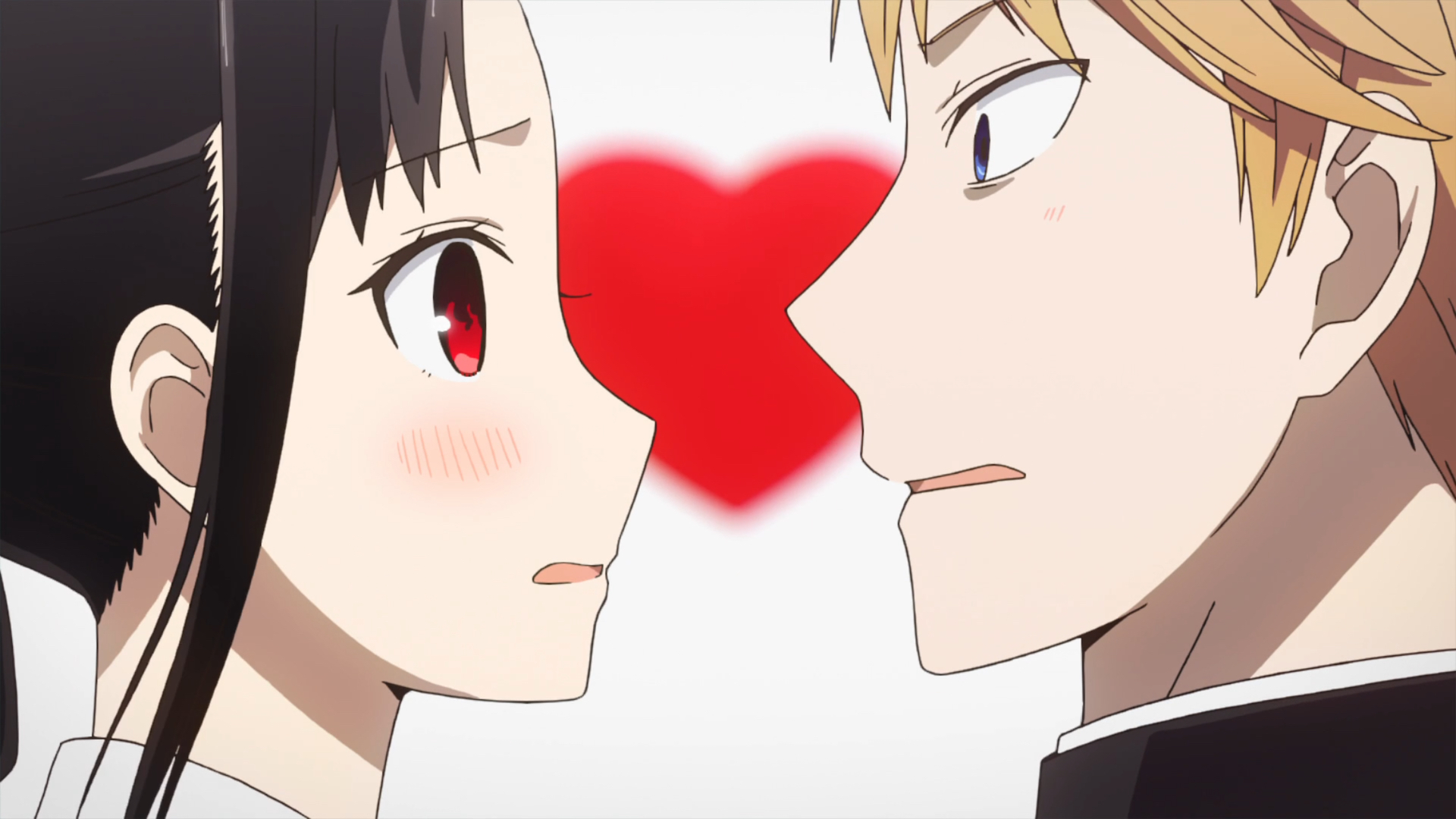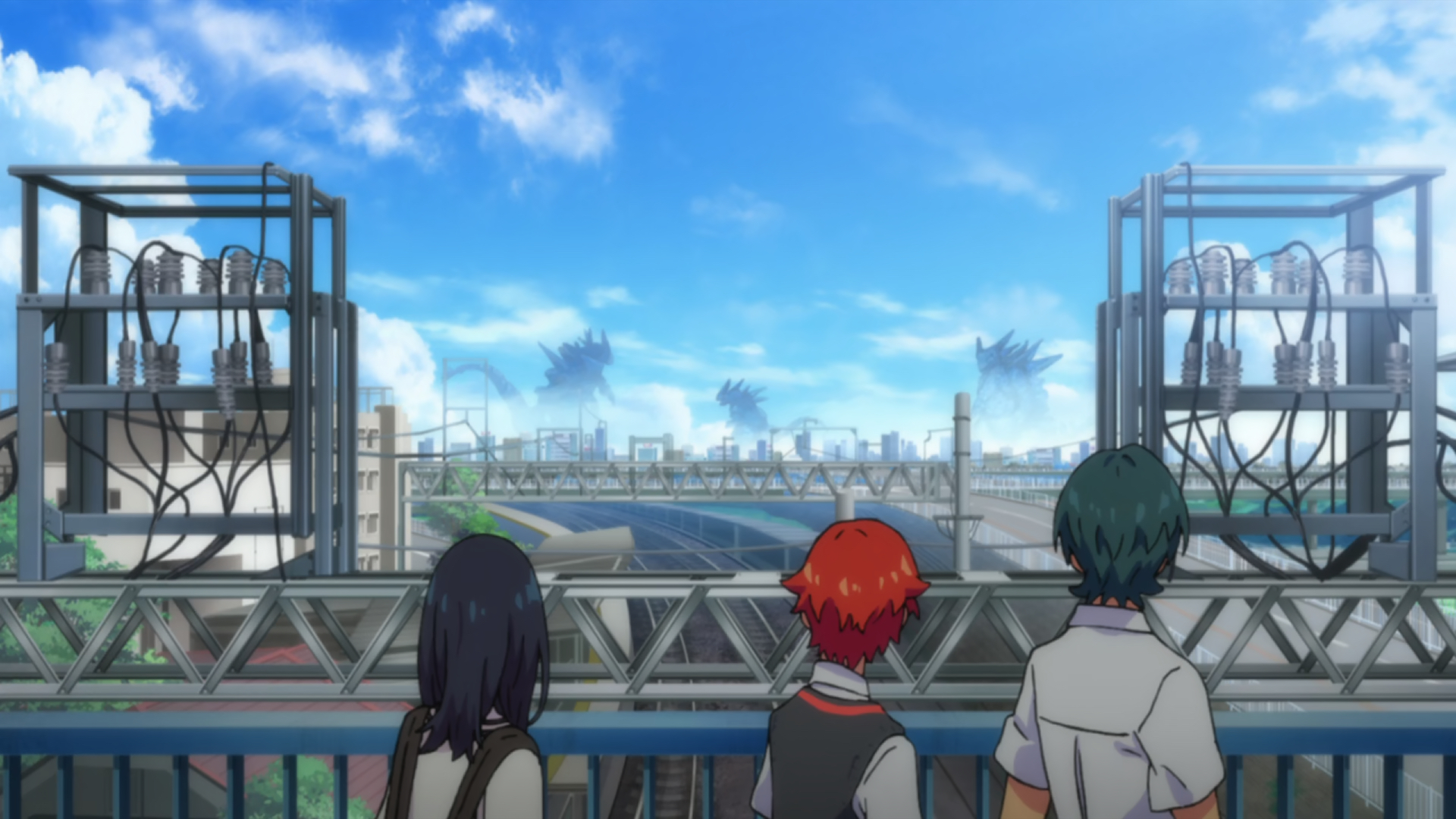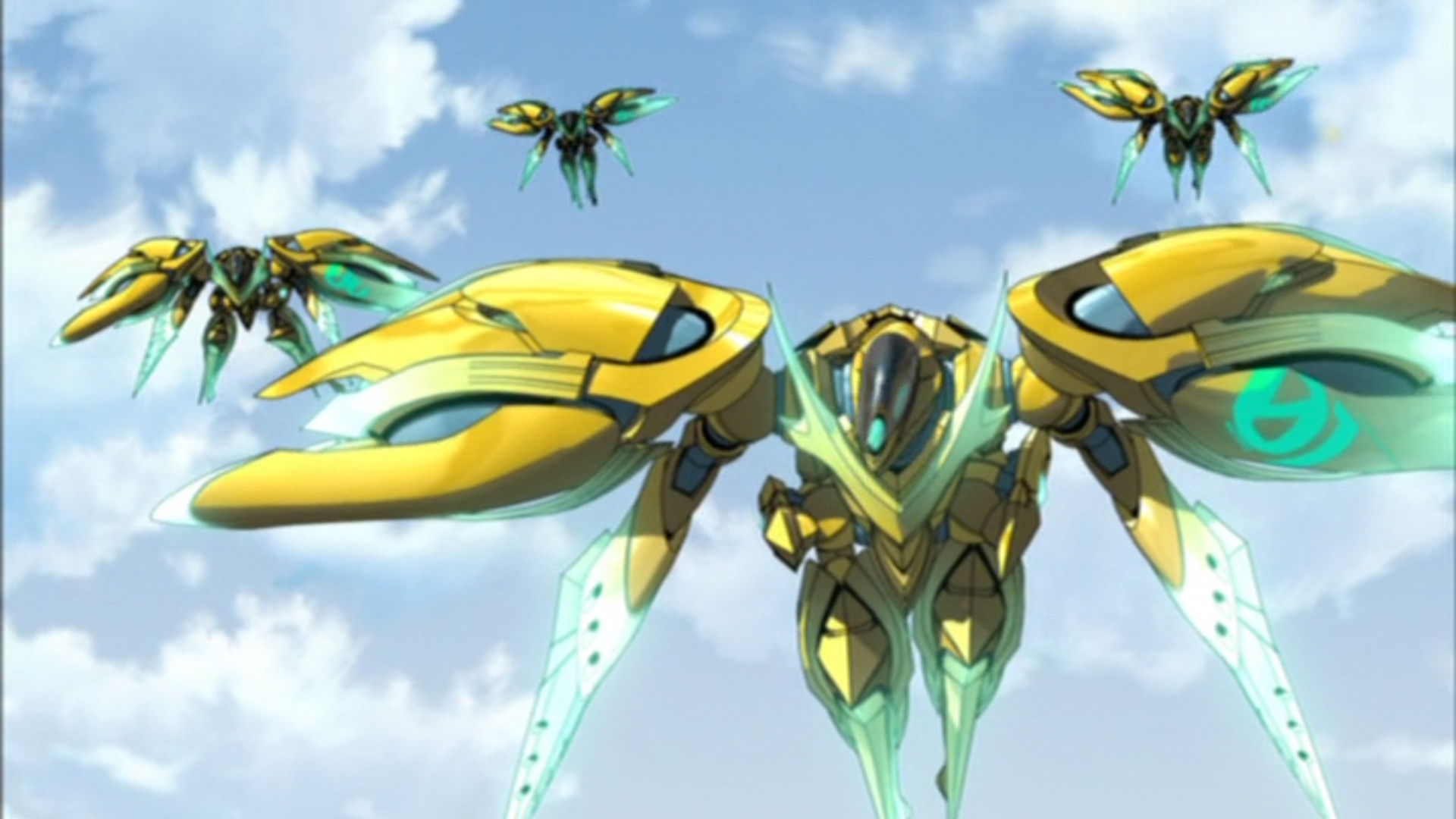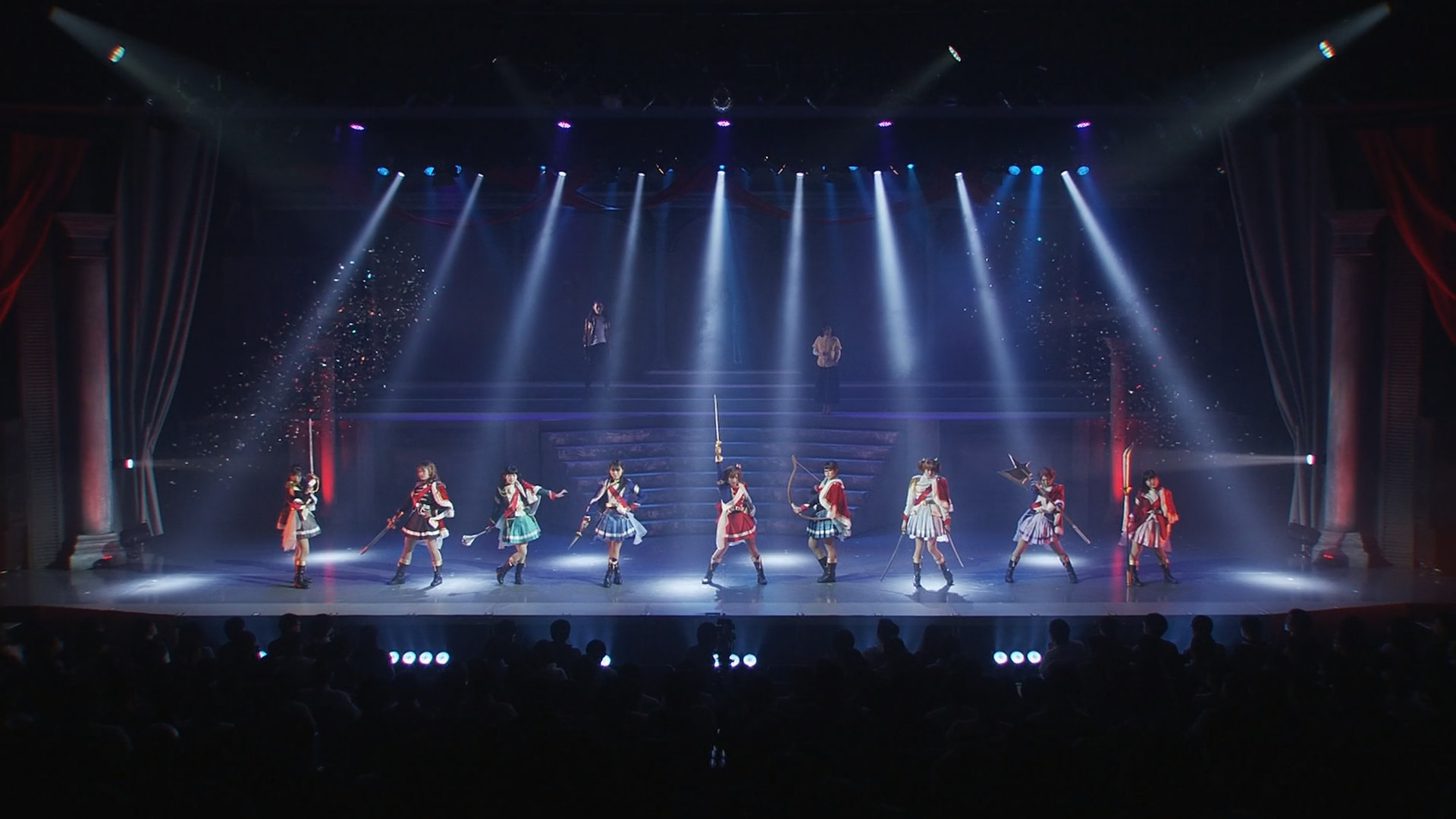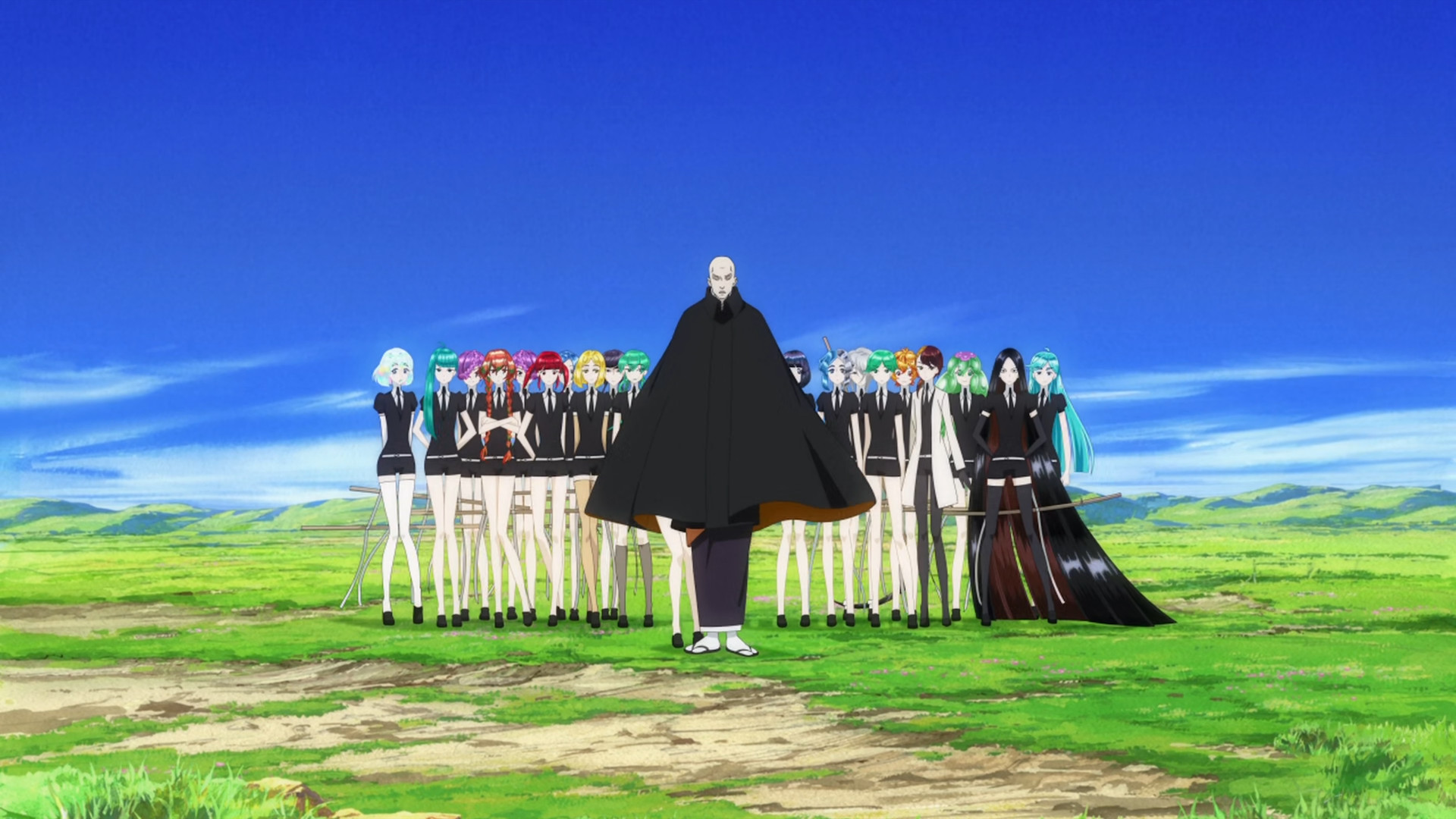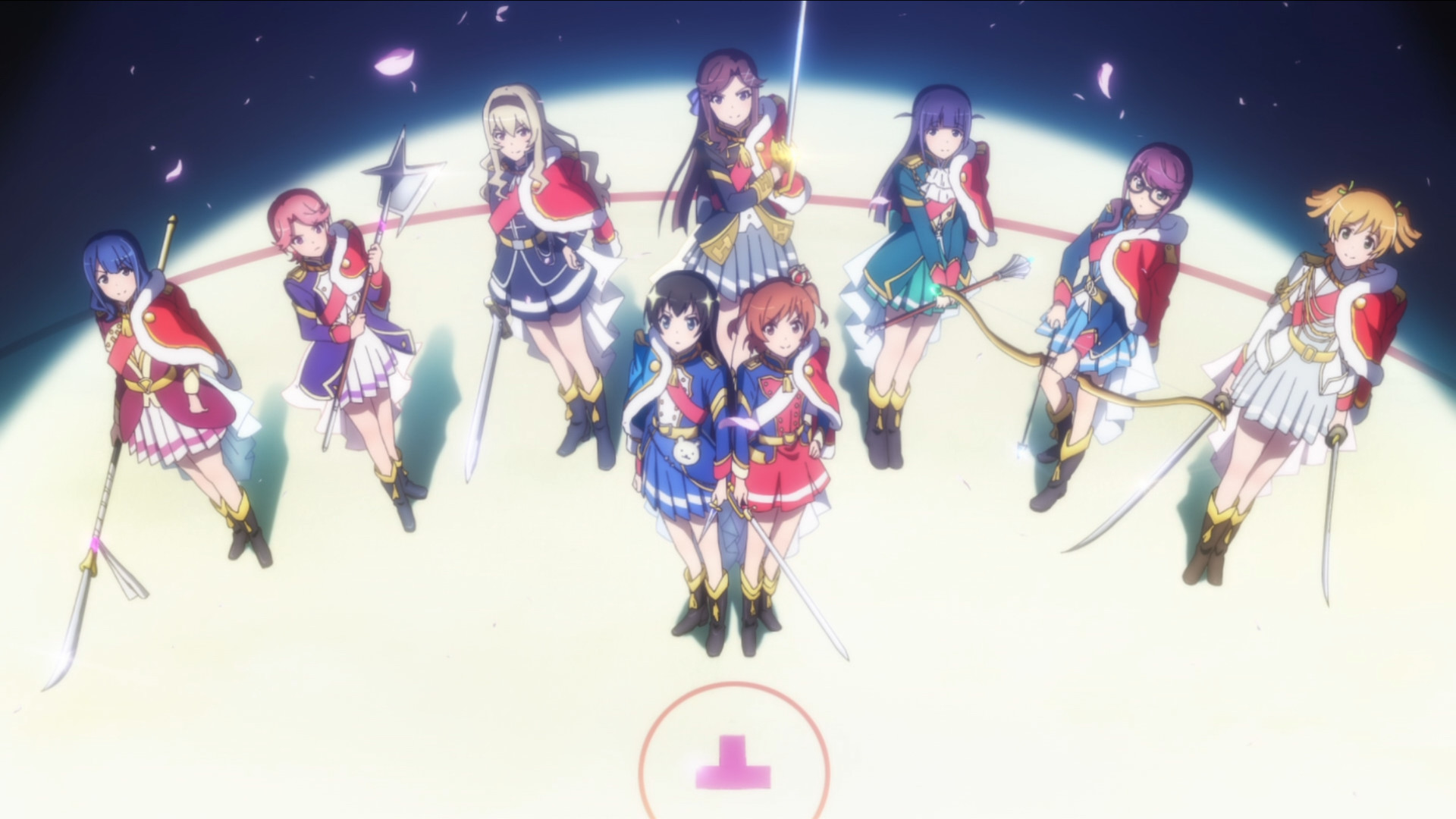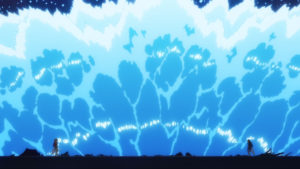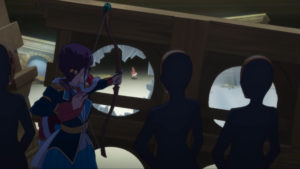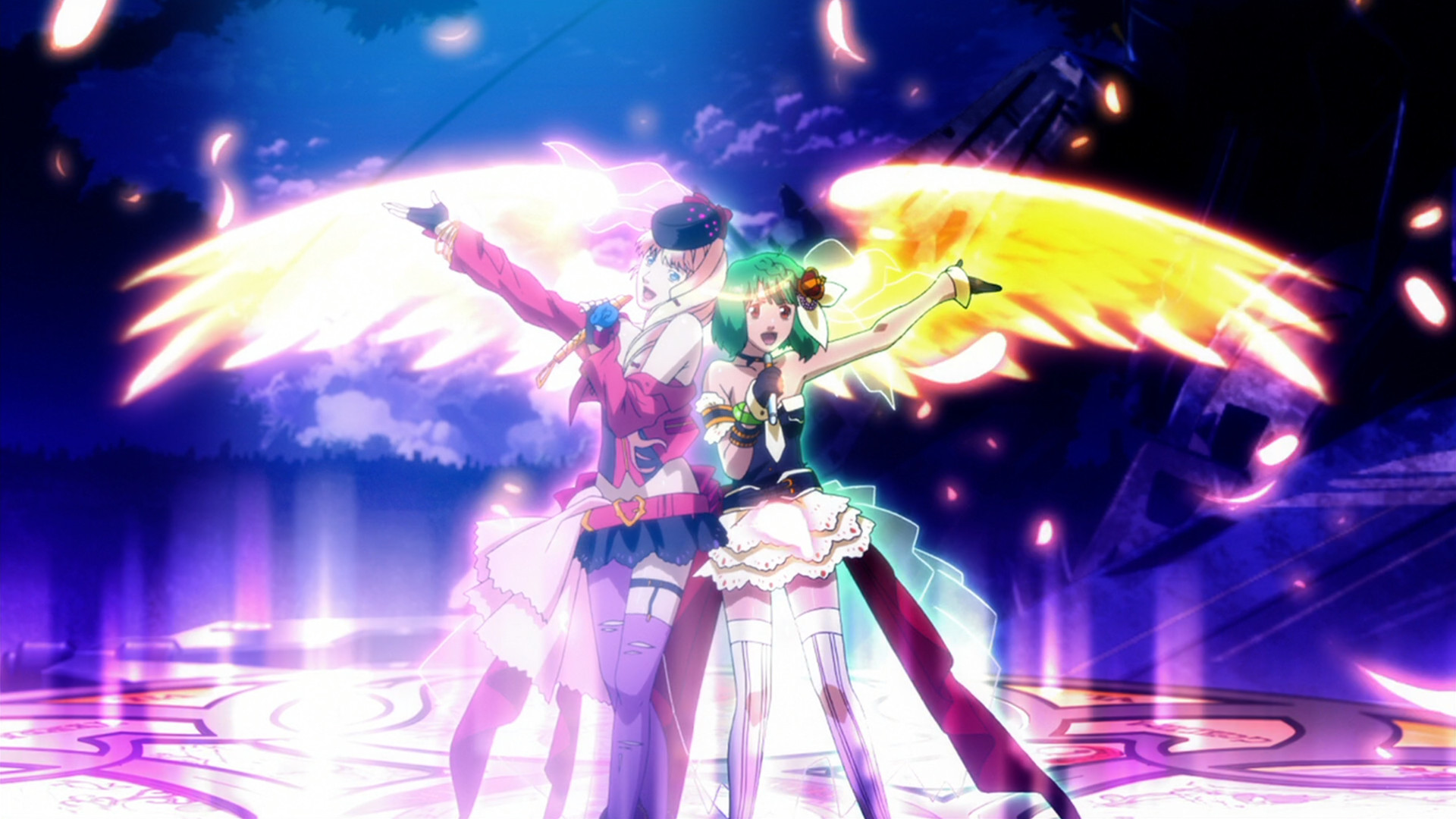Review: Kaguya-sama: Love Is War
In Short:
Kaguya-sama: Love Is War is a 2019 anime from the well known studio A-1 Pictures. In it, our two main characters, the President and Vice President of their prestigious academy’s student council, play hilarious, ever escalating mind games with each other in an attempt to force the other to be the first one to declare their love.
This is a bombastic, over the top show with off the wall situations and zany, stylized animation. It’s certainly possible that some may not like its presentation or its largely disconnected episodic nature.
Suggested Watch Minimum: 1 episode. Although the show develops a bit more of an ongoing story in later episodes, the crazy situations and misunderstandings that make up much of the show are well represented in the first episode.
Full Review:
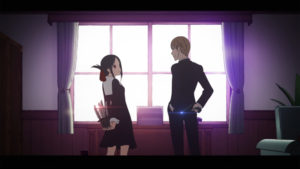 Love Is War’s inventive animation, wacky sense of humor, and crazy, bite-sized stories pulled me in almost immediately. We chiefly follow two main characters: Miyuki Shirogane, a smart, well-mannered, but financially poor high schooler who is the student council president of Shuchiin Academy. Opposite him is its student council vice president, Kaguya Shinomiya, who is the polite, clever, but heavily sheltered daughter of one of the Japan’s largest multi-corporation conglomerates.
Love Is War’s inventive animation, wacky sense of humor, and crazy, bite-sized stories pulled me in almost immediately. We chiefly follow two main characters: Miyuki Shirogane, a smart, well-mannered, but financially poor high schooler who is the student council president of Shuchiin Academy. Opposite him is its student council vice president, Kaguya Shinomiya, who is the polite, clever, but heavily sheltered daughter of one of the Japan’s largest multi-corporation conglomerates.
These two are crazy for each other, but there’s a problem: They both believe that being the first to admit their love will make them subservient to the other. In order to prevent that, the two keep their feelings a closely guarded secret from each other even as they spend much of their school days together in the large student council offices. Since neither one wants to admit their love, they engage each other in outwardly calm and subtle but inwardly dramatic and over the top mind games where they try and force the other to admit the feelings they are sure are there just beneath the surface. Seeing as our two main characters come from vastly different background, their attempts to force the other’s declaration of love vary in fun ways.
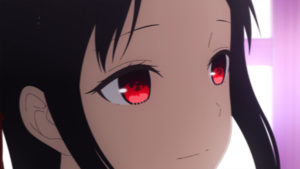 Kaguya Shinomiya comes from the massively wealth and powerful Shinomiya family, so her tactics tend to be based on her limitless wealth and power… but she’s also massively sheltered so she tends to devise absurdly complex schemes only to be foiled by her own shyness or naivety. Her biggest fear is giving up her high standards just because she’s fallen for someone. Her most endearing quality is the way she sometimes freezes up when her plans go too right too quickly.
Kaguya Shinomiya comes from the massively wealth and powerful Shinomiya family, so her tactics tend to be based on her limitless wealth and power… but she’s also massively sheltered so she tends to devise absurdly complex schemes only to be foiled by her own shyness or naivety. Her biggest fear is giving up her high standards just because she’s fallen for someone. Her most endearing quality is the way she sometimes freezes up when her plans go too right too quickly.
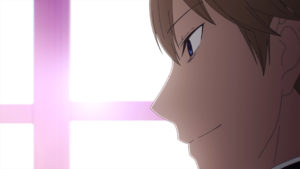 Miyuki Shirogane, on the other hand, comes from far more modest means. He only made it to the academy because of his impressive grades, not his family’s wealth, so his tactics tend to be simpler and more direct, but often fail in amusing ways. His biggest fear is doing something embarrassing and having Kaguya dismissively say to him: “How cute.” His most endearing quality is his selfless need to help others.
Miyuki Shirogane, on the other hand, comes from far more modest means. He only made it to the academy because of his impressive grades, not his family’s wealth, so his tactics tend to be simpler and more direct, but often fail in amusing ways. His biggest fear is doing something embarrassing and having Kaguya dismissively say to him: “How cute.” His most endearing quality is his selfless need to help others.
Playing a crazy, unintentional foil to our two fantastic leads is pink-haired Chika Fujiwara who is so delightful that she is very nearly the star of the show. She is so simple minded and excitable that she tends to be the hand grenade who accidentally derails the two main characters’ carefully laid plans time and time again.
 There’s also Ai Hayasaka, Kaguya’s assistant, who realizes that Kaguya and Miyuki are secretly in love and who tries to force them together in amusing ways. And there’s Yū Ishigami, an emo geek/gamer in charge of student council finance who tends to unintentionally get on the ladies’ bad side. He’ll often skulk out of the room saying “I think I’ll go home now and die…” to which someone inevitably says “ok… but please don’t actually die.” A couple of new characters are added to the student council in season two and do a great job at keeping things interesting.
There’s also Ai Hayasaka, Kaguya’s assistant, who realizes that Kaguya and Miyuki are secretly in love and who tries to force them together in amusing ways. And there’s Yū Ishigami, an emo geek/gamer in charge of student council finance who tends to unintentionally get on the ladies’ bad side. He’ll often skulk out of the room saying “I think I’ll go home now and die…” to which someone inevitably says “ok… but please don’t actually die.” A couple of new characters are added to the student council in season two and do a great job at keeping things interesting.
Most episodes are spilt into three “battles” where one side or the other tries to carry out a scheme to force the other to confess their love. One character will play their hand only to have the other counter that play in some fashion only to have that counter countered. And so it goes. During all this, they exhibit frantic worrying at whether a plan will work and wide eyed shock as one of their foolproof plans is upended with nothing more than an unexpected word or action. At the end of each battle, the ever present narrator will declare one side the winner or loser, and the episode will move on to a new situation.
What kind of schemes, you ask? Here’s a small smattering of the many many little scenarios that play out over the course of the series:
- Kaguya arranges for Miyuki and herself to receive movie tickets to a romantic movie. The two enter into a battle of wits to see who can force the other to ask them to the movies.
- Kaguya, Miyuki, and Chika play a game where they have to trick each other into saying a word each of them doesn’t know but the others can see.
- Miyuki tries to give relationship advice to a fellow male student while Kaguya secretly listens in.
- Kaguya switches Miyuki’s coffee to decaf with unexpected results.
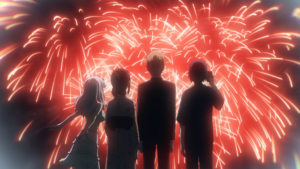 At first, the show seems like it’s not going anywhere. It’s massively fun and entertaining, to be sure, but the first few episodes are just one unrelated battle after another. But, pretty soon, you start to notice that later episodes connect to earlier ones. A plot slowly begins to form. This is not a narrative heavy show by any means, but by the end of the first season, you’ll find yourself rooting for both the main characters in ways you didn’t expect because of little plot points that have built up along the way.
At first, the show seems like it’s not going anywhere. It’s massively fun and entertaining, to be sure, but the first few episodes are just one unrelated battle after another. But, pretty soon, you start to notice that later episodes connect to earlier ones. A plot slowly begins to form. This is not a narrative heavy show by any means, but by the end of the first season, you’ll find yourself rooting for both the main characters in ways you didn’t expect because of little plot points that have built up along the way.
The second season has a bit more of a running plot, but it too has a lot of loosely connected witty one-off battles. It’s interesting to note, though, that the title changes in the second season from “Love Is War!” to “Love Is War?” The title change matches the slowly shifting objectives of the lead characters as they being to realize that, yes, the other is in love with them.
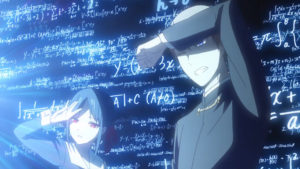 Animation wise, this is not exactly a powerhouse in a traditional sense. A lot of episodes take place in the familiar, large-ish student council room or in other reused parts of the academy. There’s a lot of minimally animated close ups and slow panning shots. But, that’s not to say the show cheaps out in any way. Love Is War goes to extraordinarily lengths to mix things up as its two leads dive deeper and deeper into their crazy plots. The show shifts to absurd charactatures, and complex moving backgrounds, and constantly changing over the top special effects as it visualizes each characters’ thought processes. The show’s art is totally absurd and off the wall, at times, but it totally works!
Animation wise, this is not exactly a powerhouse in a traditional sense. A lot of episodes take place in the familiar, large-ish student council room or in other reused parts of the academy. There’s a lot of minimally animated close ups and slow panning shots. But, that’s not to say the show cheaps out in any way. Love Is War goes to extraordinarily lengths to mix things up as its two leads dive deeper and deeper into their crazy plots. The show shifts to absurd charactatures, and complex moving backgrounds, and constantly changing over the top special effects as it visualizes each characters’ thought processes. The show’s art is totally absurd and off the wall, at times, but it totally works!
When talking about animation, I’ve also got to heap praise on the shows’ various openings and closings. The season one opening feels like something out of a James Bond film with lots of complex shots and interesting imagery of our two leads at war with each other. The second season opens with a fun, quickly told miniature story typical of the show’s longer battles. Both openings are set to some downright groovy soundtracks that you’ll find yourself humming long after you finish the show. The closings of the seasons are also well worth watching. 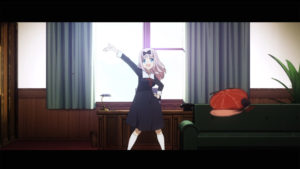 They are strange and fascinating in their own ways.
They are strange and fascinating in their own ways.
And then, there’s the one-off closing for episode 3 of the first season. Titled “Chika Dance”, it features about a minute of some of the most absurdly detailed character animation you’ve ever seen. This closing had the entire internet abuzz when it first debuted, and for good reason!
All In All:
This is an outstanding, goofy series that pokes fun at the absurdity of high school students who wish they could make the other declare their love but who are too smart for their own good. It’s delightful and good natured while being laugh out loud funny several times an episode. And, as the series progresses, it does gradually reveal that it actually has some heart tucked away somewhere between all the absurdity.
Review: SSSS.Gridman
In Short:
SSSS.Gridman is a 2018 anime by Studio Trigger that centers around four high school students living in a seemingly normal world, one of whom transforms into the building-sized, robot-looking hero known as Gridman in order to protect his city from equally large kaiju monsters. The show is packed full of great animation, terrific action, excellent characters, and stand out music, as well as a well told plot that has some nicely hidden depth.
Suggested Watch Minimum: 2 episodes. You need to see the full results of the first kaiju attack before making a decision on SSSS.Gridman.
Full Review:
SSSS.Gridman, for me, was an “eh, I might as well try it” kind of show. I’m not such a big fan of Godzilla, Power Rangers, or the numerous “giant-sized hero fights giant monsters who are very obviously guys in monster suits” type shows. They always felt too cheap and silly to me. SSSS.Gridman, though, knocked the formula clear out of the park, scoring a grand slam, a drop goal, and an extra point all at the same time. Yes, it’s that good!
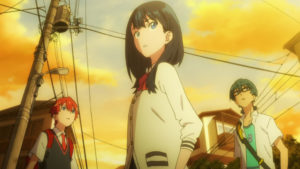 It’s a little hard to say much about SSSS.Gridman given that I tend to be a little more protective of first time viewers of shows I really like. At its core, the show is about four high school students: Hibiki Yūta – a normal student who wakes up one evening with amnesia, Utsumi Shō – something of a nerd and lover of old kaiju shows, and Rikka Takarada – a girl who would prefer a normal life and is shocked by what takes place around her. There’s also Akane Shinjō, who hates it when things don’t go her way.
It’s a little hard to say much about SSSS.Gridman given that I tend to be a little more protective of first time viewers of shows I really like. At its core, the show is about four high school students: Hibiki Yūta – a normal student who wakes up one evening with amnesia, Utsumi Shō – something of a nerd and lover of old kaiju shows, and Rikka Takarada – a girl who would prefer a normal life and is shocked by what takes place around her. There’s also Akane Shinjō, who hates it when things don’t go her way.
One day, kaiju start appearing in the city, and it’s up to Hibiki to merge with Gridman, some sort of high tech computer based guardian, in order to put a stop to them. Along the way, Gridman picks up new allies and enemies as the ongoing conflict escalates. As the show continues, we learn more about the why these monstrous kaiju are attacking the city, and who is sending them. The answers are interesting and character driven and go far beyond the typical “an evil villain did it.”
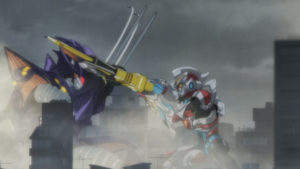 SSSS.Gridman features insane, highly detailed action sequences, great effects, wonderful character animation, and some high octane action music that lets the show kick ass every episode. The battle scenes have that same “these monsters are moving really fast but are also really big so they look slow and powerful” feel that Pacific Rim had a few years back. When Gridman appears, he typically lands in the street and the entire surrounding city shakes as cars and debris are thrown dozens of feet into the air. The attention to detail is just outstanding. And so is the combat. From massive energy beams to rocket accelerated punches, to classic kaiju throws, SSSS.Gridman delivers.
SSSS.Gridman features insane, highly detailed action sequences, great effects, wonderful character animation, and some high octane action music that lets the show kick ass every episode. The battle scenes have that same “these monsters are moving really fast but are also really big so they look slow and powerful” feel that Pacific Rim had a few years back. When Gridman appears, he typically lands in the street and the entire surrounding city shakes as cars and debris are thrown dozens of feet into the air. The attention to detail is just outstanding. And so is the combat. From massive energy beams to rocket accelerated punches, to classic kaiju throws, SSSS.Gridman delivers.
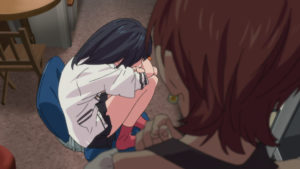 Gridman saves the city from the kaiju time and time again as our three friends try to figure out what’s causing it all. The things they learn are pretty shocking. Out of our three leads, I really enjoyed the realistic human emotions given to Rikka. The way she frets over her friends throughout the series, even to the point of inaction, felt very believable and very well done to me.
Gridman saves the city from the kaiju time and time again as our three friends try to figure out what’s causing it all. The things they learn are pretty shocking. Out of our three leads, I really enjoyed the realistic human emotions given to Rikka. The way she frets over her friends throughout the series, even to the point of inaction, felt very believable and very well done to me.
I’d be remiss if I didn’t specifically mention the music. It’s interesting in that SSSS.Gridman actually doesn’t use music that often, and when it does, it mainly uses its opening theme “Union” as Gridman’s upbeat battle song. And that’s kinda it. Most of the non-action scenes don’t have significant music backing them, but it works because the tension and dialogue keep things moving just fine on their own. But, wow, when the show does use music, it does so perfectly to further amp up the action.
All In All:
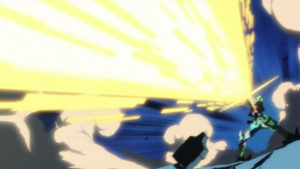 I’ve got no real wrap-up this time. I’m just here to say good things about SSSS.Gridman. Great art. Great animation. Great action. Great characters. Great plot. Great music. And some nicely hidden depth to its story and characters. Just go watch SSSS.Gridman, already.
I’ve got no real wrap-up this time. I’m just here to say good things about SSSS.Gridman. Great art. Great animation. Great action. Great characters. Great plot. Great music. And some nicely hidden depth to its story and characters. Just go watch SSSS.Gridman, already.
Oh, and be sure to watch until literally the very last second or you will miss out! You’ll also want to watch the official music video of “Union” by OxT for a final few scenes of closure after you finish the series.
I held off talking about the plot until this section because it is so tied up with the mental state of Akane Shinjō. The show takes some care to obscure her role in the story for the first episode, but from the second episode on it’s clear she is the driving force behind everything. And, as the story unfolds more and more, we find out that “everything” really does mean “everything.”
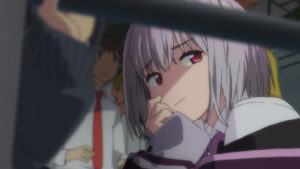 It turns out Akane is dreaming, and everything in her dream city is set up for her by her. The city layout. The school. Even all the people who populate the city. None of them are real. All of them are geared to the ideal world that Akane wishes she lived in. Including our three main characters. Even Akane is an idealized version of her true self in this dream world!
It turns out Akane is dreaming, and everything in her dream city is set up for her by her. The city layout. The school. Even all the people who populate the city. None of them are real. All of them are geared to the ideal world that Akane wishes she lived in. Including our three main characters. Even Akane is an idealized version of her true self in this dream world!
Take a closer look at Akane. In her dream world, she is a back row student with big breasts and oddly bleached hair who lives alone in a house packed with kaiju models and garbage bags. Despite not really ever doing anything other than sitting at her desk, she is easily the most popular girl in the entire school. Everyone wants to hang out with her all the time. They’re almost always gathered around her desk. Everything about Akane, her looks, her popularity, her carefree living conditions, they’re all made up and made perfect to one extent or another.
What does this say about the real world Akane? Does she not like her appearance? Does she wish she was more popular? Does she enjoy kaiju but has to keep her like of monster movies and models a secret? Maybe! But let’s keep going.
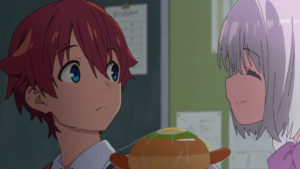 Think about Hibiki. Near the end of the series, Gridman says he was only able to take over Hibiki’s body because… and then something distracts Gridman and we don’t hear the reasoning!
Think about Hibiki. Near the end of the series, Gridman says he was only able to take over Hibiki’s body because… and then something distracts Gridman and we don’t hear the reasoning!
But, I think we can tease out what he was going to say. Right near the end of the series, in the final episode, Rikka and Utsumi again speculate on why Gridman choose Hibiki and we’re shown a very interesting scene. We see Akane at her desk surrounded by her many friends, but then there’s Hibiki sitting beside her, not paying her any attention. Instead, he’s looking towards Rikka at the front of the room. And they notice each other. There’s a spark between them! In Akane’s perfect world, a world where everyone was built to like her, the boy she sits beside took an unexpected interest in someone other than her!
During the series, we see that Akane’s creations can have free will. Hibiki, Utsumi, and Rikka reject her perfect dream worlds. Anti overcomes his programming and instead of fighting against Gridman he fights with him. I think maybe Hibiki was the first person, and at that point the only person in Akane’s entire city, to actively go against her designs. That’s pretty cool.
 But, there’s another, super fascinating layer to that. We know Akane can’t control a whole world by herself based on what she said near the very end. Even creating a river rafting play space for a day trip takes her time and effort. So, it seems likely that she also didn’t hand design each and every person in her city or even in her classroom. Rather, the city, the classroom, and all the people in her dream world are copies or replicas of people and places she knows from the real world. Maybe Hibiki is a representation of a boy she likes in school? That could make sense. Akane clearly likes him in the dream world, and is attracted to him. It even takes her to the next to the last episode to physically attack him despite knowing that he’s the one constantly messing up her plans. She targeted and killed people with her kaiju for far less than that!
But, there’s another, super fascinating layer to that. We know Akane can’t control a whole world by herself based on what she said near the very end. Even creating a river rafting play space for a day trip takes her time and effort. So, it seems likely that she also didn’t hand design each and every person in her city or even in her classroom. Rather, the city, the classroom, and all the people in her dream world are copies or replicas of people and places she knows from the real world. Maybe Hibiki is a representation of a boy she likes in school? That could make sense. Akane clearly likes him in the dream world, and is attracted to him. It even takes her to the next to the last episode to physically attack him despite knowing that he’s the one constantly messing up her plans. She targeted and killed people with her kaiju for far less than that!
So then, what about Rikka? I think Rikka is a lot more interesting than she first appears and is more critical to the plot than is stated out loud. Think back to all the times Rikka and Akane interact. Think of how Akane singles Rikka out to be her friend when she has people fawning over her already. Take note of all the similarities between Akane and Rikka. For instance:
- In the dream world, Rikka and Akane live directly next door to each other, a coincidence Akane must have designed.
- They both hate walking to school when it’s hot out so they take the bus on hot sunny days.
- They dislike the group date with Arcadia for very nearly the exact same reasons.
- They don’t want to join a high school club and both would just rather go home at the end of the day.
- They excuse themselves from awkward situations in the same formal manner.
- They both dislike school festivals.
- They both are prone to getting depressed and curling in on themselves with their knees against their chests when they’re upset.
- And, this is the big one, Rikka in the dream world has the hair and build of Akane when she wakes up in the real world!
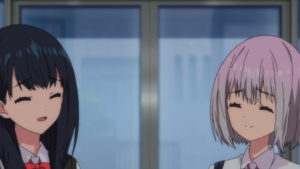 Here’s what I think happened. Unlike Hibiki, Rikka isn’t a copy of a real world friend used to populate Akane’s dream world. No. She is, in actuality, Akane’s projection of her real world self!
Here’s what I think happened. Unlike Hibiki, Rikka isn’t a copy of a real world friend used to populate Akane’s dream world. No. She is, in actuality, Akane’s projection of her real world self!
To put it more simply: Rikka is Akane.
There are so many scenes where Akane and Rikka react the same, talk the same, and even move the same. I didn’t notice this the first time through, but watching the show again a second time, knowing that Rikka is Akane’s creation the entire time, it just jumped out at me how similar the two are.
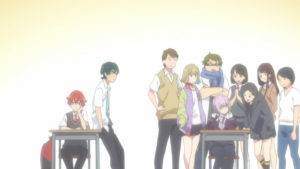 And that ties back in to Gridman and Hibiki in a fun way. Hibiki, the boy that Akane created, the one she choose to sit by in class, the one who should be drawn to her just like everyone else. He actually did like her. Did fall for her. He just fell for Rikka, the more real version of her. I think Akane subconsciously set up Hibiki to like her, but he saw through the fake version Akane choose for herself and ended up liking the more realistic version by mistake. And that little, unintentional defiance on Hikibi’s part gave Gridman his way in to help save Akane from herself. That’s pretty cool!
And that ties back in to Gridman and Hibiki in a fun way. Hibiki, the boy that Akane created, the one she choose to sit by in class, the one who should be drawn to her just like everyone else. He actually did like her. Did fall for her. He just fell for Rikka, the more real version of her. I think Akane subconsciously set up Hibiki to like her, but he saw through the fake version Akane choose for herself and ended up liking the more realistic version by mistake. And that little, unintentional defiance on Hikibi’s part gave Gridman his way in to help save Akane from herself. That’s pretty cool!
As for Utsumi? I wonder if he’s not a projection of Akane’s kaiju obsession in some way.
Let’s see… what else?
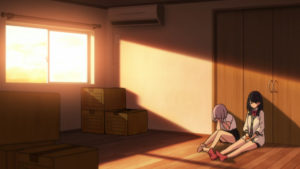 I really liked Akane’s choice to leave. Her friends convinced her that it’s no good being alone. That she needs to lean on and rely on the people around her. And so she does, but she also says that she’s done too many terrible things to her fictional world and that she needs to choose to leave it and go back to her real world. The first time around, I thought her choice was simply to vanish at the end. But no. It was a lot more deliberate than that! Look closer. She packed up her room. She cleaned up all the trash. She placed all her things into neat, tidy, sealed moving boxes. It was a very deliberate act on her part to go away. And when she does vanish, note that all her boxes leave with her while Rikka stays behind in that empty room in Akane’s empty house. It was a powerful moment, and also one that I think fully confirms that Akane’s dream world will continue on without her.
I really liked Akane’s choice to leave. Her friends convinced her that it’s no good being alone. That she needs to lean on and rely on the people around her. And so she does, but she also says that she’s done too many terrible things to her fictional world and that she needs to choose to leave it and go back to her real world. The first time around, I thought her choice was simply to vanish at the end. But no. It was a lot more deliberate than that! Look closer. She packed up her room. She cleaned up all the trash. She placed all her things into neat, tidy, sealed moving boxes. It was a very deliberate act on her part to go away. And when she does vanish, note that all her boxes leave with her while Rikka stays behind in that empty room in Akane’s empty house. It was a powerful moment, and also one that I think fully confirms that Akane’s dream world will continue on without her.
The last thing I’d like to note is the final thirty seconds of the series. The part where Akane wakes up in the real world. At first I saw it as a cop out. “It was all a dream!” is one of the worst turns a story can take. But here, the ending doesn’t take away from the story. It’s a continuation of it. It adds closure to it.
 Multiple times during the show, most notably during episode 9 where everyone was dreaming, Akane is told that she too needs to wake up from her dream. And she does! But the coolest part of that is, her story doesn’t end with the end of the show. Go watch the official music video of OxT’s “Union”. We see Akane wake up and go out to meet up with her friends, possibly to tag along with them on the way to school.
Multiple times during the show, most notably during episode 9 where everyone was dreaming, Akane is told that she too needs to wake up from her dream. And she does! But the coolest part of that is, her story doesn’t end with the end of the show. Go watch the official music video of OxT’s “Union”. We see Akane wake up and go out to meet up with her friends, possibly to tag along with them on the way to school.
I think the takeaway there is the real Akane had some sort of trouble at school. Perhaps boy trouble. She went home mad, depressed, angry. She had a dream where she ruled everything and could fix anything she didn’t like. During that dream, the alien Alexis Kerib invaded her mind and gave her the power to shape her world by making kaiju. She got so tied up in it and in her negative emotions that eventually she even saw killing as ok as long as it made her feel better. But then, Gridman came and together with some of the created inhabitants of Akane’s dream world, he managed to remind her that she had friends she could rely on. When she wakes up in the real world, she feels better about herself and the first thing she does is go track down and join up with her friends.
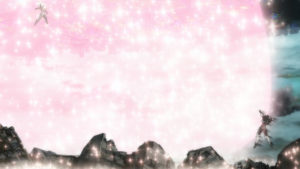 One last thing worth noting is an area I don’t have a ton of knowledge in but should be pointed out anyway. SSSS.Gridman is based on and may be even a direct continuation of the 1993 Japanese live action show “Gridman the Hyper Agent”. Many of the things that seem to come out of nowhere like the Fixer Beam or the kaiju girl who told Hibiki about Akane are directly related to the older series. I haven’t done anything so crazy as try to track down all the references, but just know that a lot of the unexplained didn’t just spring up from nowhere. They were probably things that happened a couple of decades ago that got a knowing mention in this new series.
One last thing worth noting is an area I don’t have a ton of knowledge in but should be pointed out anyway. SSSS.Gridman is based on and may be even a direct continuation of the 1993 Japanese live action show “Gridman the Hyper Agent”. Many of the things that seem to come out of nowhere like the Fixer Beam or the kaiju girl who told Hibiki about Akane are directly related to the older series. I haven’t done anything so crazy as try to track down all the references, but just know that a lot of the unexplained didn’t just spring up from nowhere. They were probably things that happened a couple of decades ago that got a knowing mention in this new series.
Review: Strain: Strategic Armored Infantry
In Short:
Strain: Strategic Armored Infantry is a 2006 sci-fi anime from Studio Fantasia that follows cadet Strain pilot Sara Werec as she pursues her older brother across the stars looking for answers after he betrays her. The show offers interesting takes on depression, determination, and mech-based space combat. It also makes novel use of the time dilation effects of faster than light travel as part of its core plot.
Though I enjoy the show and its themes a great deal, it is decidedly not in the top tier of anime. It simply does not reach any kind of “best of the best” status across plot, animation, sound, or music… though the battle theme is pretty good. There’s also an unfortunate fan service episode in episode 7 that can almost be entirely skipped.
Suggested Minimum Watch: 2 episodes. You need to see Sara before and after the attack on planet Grabera before making a decision on the series.
Full Review:
I first found Strain: Strategic Armored Infantry in my early days of anime. It was one of the first I watched during the earliest days of Funimation streaming, and it stuck with me all these years later.
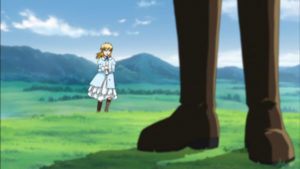 The story starts with Sara Werec, a young girl who faces the prospect of never seeing her beloved older brother again. You see, her brother, Ralph, is a Reasoner: a pilot trained to fly large, mech-like space fighters called Strains. Ralph is being deployed to the front lines of humanity’s long running civil war several light years away and due to the effects of time dilation caused by faster than light travel, this means young Sara will grow up, grow old, and die before Ralph is able to return. In order to again see her brother, Sara makes a choice to follow in his footsteps and become a Strain pilot herself.
The story starts with Sara Werec, a young girl who faces the prospect of never seeing her beloved older brother again. You see, her brother, Ralph, is a Reasoner: a pilot trained to fly large, mech-like space fighters called Strains. Ralph is being deployed to the front lines of humanity’s long running civil war several light years away and due to the effects of time dilation caused by faster than light travel, this means young Sara will grow up, grow old, and die before Ralph is able to return. In order to again see her brother, Sara makes a choice to follow in his footsteps and become a Strain pilot herself.
We catch up to Sara a few years later as she and her fellow cadet Reasoners are nearing graduation at their Strain pilot training academy. Sara, like her brother, has become one of the best of the best, and she can’t wait to head out to the front lines to finally meet up with him. Unfortunately, fate has other things in store for her. When Sara’s university on planet Grabera comes under attack by enemy forces, she and her friends board their Strains in order to push back the enemy. They do well at first, but then learn that Ralph and his advanced Strain are leading the enemy’s attack! After defeating nearby opposition, including Sara, Ralph breaks into a research facility to steal a strange girl being held there. He then departs leaving his battered younger sister behind traumatized and in need of answers.
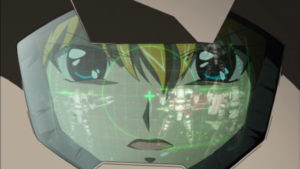 Having lost her ability to pilot a Strain due to her brother’s attacks, Sara’s quest should be over, but her need for answers won’t let her quit. She changes her name and reenlists in the military in secret as a pilot in the much slower rank and file Gambee mech squadrons. Though she is deeply frustrated and deeply traumatized, Sara continues after her brother no matter the risks or abuses she faces along the way.
Having lost her ability to pilot a Strain due to her brother’s attacks, Sara’s quest should be over, but her need for answers won’t let her quit. She changes her name and reenlists in the military in secret as a pilot in the much slower rank and file Gambee mech squadrons. Though she is deeply frustrated and deeply traumatized, Sara continues after her brother no matter the risks or abuses she faces along the way.
It’s Sara’s determination that really kept me with the show. She’s stuck piloting a machine that her Strain could run circles around and she has to keep her identity hidden unless she wants to face endless questions about her loyalty given the atrocities her brother committed. Perhaps even worse, her fellow rank and file pilots treat her terribly as she is relearning the ropes and pushing herself far too hard in order to reach the front lines as soon as possible. Sara’s now silent, determined attitude doesn’t win her any friends, either, but there is something oddly compelling about how she endures emotional and occasional physical abuse all without complaining or lashing out in return.
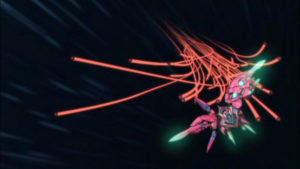 Eventually, Sara does find a way to pilot a Strain again, and it’s interesting to watch as she is encouraged back out of her trauma and depression. She has to learn to trust others again, all while still protecting her biggest, darkest secrets. That she continues to hide her true identity creates some nice moments of tension in later episodes. After all, her brother didn’t just betray her, he hurt a lot of people, and Sara is forced to deal with that fact eventually.
Eventually, Sara does find a way to pilot a Strain again, and it’s interesting to watch as she is encouraged back out of her trauma and depression. She has to learn to trust others again, all while still protecting her biggest, darkest secrets. That she continues to hide her true identity creates some nice moments of tension in later episodes. After all, her brother didn’t just betray her, he hurt a lot of people, and Sara is forced to deal with that fact eventually.
All of this might have come to nothing if we never leaned why Ralph did what he did, but we do learn his motivations. By the end of the show, Ralph’s own story is revealed and those facts place a new twist on his actions.
 Unfortunately, as much as I like Sara and the emotional journey she’s forced down, she’s kinda the only character worth following. Ok… there’s Lottie, an ace Strain pilot almost as good as Sara who has her own story of sadness similar to Sara’s, and there’s Carris who gets a smidge of characterization late in the series, but really none of the other characters matter all that much. All the other minor characters might have their one differentiating trait… one is shy… another likes meat… but whatever. The show is just not given much to work with in terms of characters.
Unfortunately, as much as I like Sara and the emotional journey she’s forced down, she’s kinda the only character worth following. Ok… there’s Lottie, an ace Strain pilot almost as good as Sara who has her own story of sadness similar to Sara’s, and there’s Carris who gets a smidge of characterization late in the series, but really none of the other characters matter all that much. All the other minor characters might have their one differentiating trait… one is shy… another likes meat… but whatever. The show is just not given much to work with in terms of characters.
Animation wise, aside for forever being stuck at low DVD 480p resolution, Strain: Strategic Armored Infantry is… fine. The show has the occasional neat scene or neat bit of art, a city built within a hollowed out asteroid looks pretty cool, for instance, but for the most part there’s no big wow factor. Even the combat of the fast moving Strains and their battles with the clouds of numerous explosive robotic “tumors” is a bit bland and confusing. Sara and the other Strain pilots fight enemies that latch on and explode by… chopping them at close range with arm blades? Some of the crossing attack patterns are cool, but again, overall the combat seems like it needs another round of thought to be truly compelling.
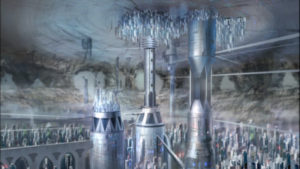 The same rating of “ok, but a bit bland” goes for the character animations and backgrounds and even the show’s music. I would, however, like to give a little shout out to the show’s battle theme which actually has a bit of fun punch to it. Despite everything else, I did find myself getting a little pumped up whenever that theme kicked in.
The same rating of “ok, but a bit bland” goes for the character animations and backgrounds and even the show’s music. I would, however, like to give a little shout out to the show’s battle theme which actually has a bit of fun punch to it. Despite everything else, I did find myself getting a little pumped up whenever that theme kicked in.
All In All:
There are space anime with more compelling casts, better art, and more exciting action, but that doesn’t mean that Strain is not worth watching. Sara’s highs and lows are fairly compelling. The core story is actually kinda clever in the way it uses the sci-fi setting. The resolution is genuinely good. Just… watch out for episode 7, the out of place goofy fan service episode.
The story of Ralph Werec, his mission to save the research ship, and the crazy time dilation effects he experiences chasing the ship down are really cool. Because of the speed at which Ralph traveled, most of his story took place long after the events of the anime. He was then sent back in time to avenge the aliens he unknowingly killed.
6361 – Aliens first discovered
7003 – Ralph is deployed to save the research ship
7005 – Ralph defeats the remaining alien fighters, Sara is defeated by Ralph on Grabera
7012 – Sarah’s final battle against Ralph begins
7137 – Sarah defeats Ralph
7564 – Ralph get to research ship and is sent back in time – yes, long after the events of the anime!
It gets a little tricky. All the dates except the last one are listed in Ralph’s local time. The last one is in Sara’s and shows the full effects of Ralph’s faster than light travel. The research ship under attack sent a signal to the union forces who then had centuries to develop Strains and come to their rescue? Does it work? Do the timelines match up? I’m not actually totally sure!
Even so, I really like the time travel part of the plot. Even if the dates don’t align perfectly, the idea that time dilation could let you deploy piloting a fighter that was invented based on technology still on the ship you are being sent to save is pretty trippy. I applaud that cool bit of sci-fi!
Review: Revue Starlight: The LIVE #1
In Short:
Performed a year before the release of the Revue Starlight anime, the first Revue Starlight stage play tells a similar story complete with some familiar songs and fun choreography. This stage play is notable because the nine core live action stage actresses went on to voice their same roles in the anime.
Though it may just be an unfortunate trick of the camera, a lot of the projected graphics used for character introductions and magical combat effects appear to be very dim in the DVD / Blu-Ray version of the play and are not as impactful or as easy to see as they might have been when viewed in person.
Full Review:
 I’ve come to love Revue Starlight, the anime. It combines fun characters, great music, and a strong appreciation of the stage to create an outstandingly unique show. But, Revue Starlight is more than just an anime. At this point, it’s a moderately large multi-medium franchise that includes: Three multi-volume manga, a single cour anime along with an upcoming followup movie, at least four live action stage plays, and an ongoing mobile game that continues to add new stories. It’s the first of these stage plays I’d like to focus on today.
I’ve come to love Revue Starlight, the anime. It combines fun characters, great music, and a strong appreciation of the stage to create an outstandingly unique show. But, Revue Starlight is more than just an anime. At this point, it’s a moderately large multi-medium franchise that includes: Three multi-volume manga, a single cour anime along with an upcoming followup movie, at least four live action stage plays, and an ongoing mobile game that continues to add new stories. It’s the first of these stage plays I’d like to focus on today.
First showing in 2017, “Shōjo Kageki Revue Starlight: The LIVE #1” tells a similar story to the anime where nine stage girls fight in magical Revues in order to try and win the position of the Top Star of their music academy’s 99th class. I wasn’t exactly sure what I was getting into when I decided to watch the stage play. Would it be the same story as the anime but stuck on a more limited stage? Would it be a condensed, unfinished, prototype version of the anime? Would it be a different story altogether? It turns out, it’s actually pretty good on its own merits while still being similar to the anime.
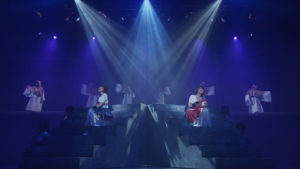 The play opens with our two main characters, Karen and Hikari, as children enjoying the pivotal, tragic scene of the in-universe Starlight stage play. We learn about the two’s promise to become stars of the stage together and of their abrupt childhood parting. We then cut to several years later and are introduced to the eight main member’s of Seisho Music Academy’s 99th class. Each is a different personality and each gets a fun self-sung musical introduction to let the audience know who they are and what they are about. From the proper, rules-following class representative Junna, to the egotistical Maya and Claudine, to the shy Mahiru and Banana, to the larger than life Kaoruko and Futaba, each character rings true. It’s only later that our lead character, Karen, is found sleeping in a separate classroom. Her musical introduction was especially fun and silly!
The play opens with our two main characters, Karen and Hikari, as children enjoying the pivotal, tragic scene of the in-universe Starlight stage play. We learn about the two’s promise to become stars of the stage together and of their abrupt childhood parting. We then cut to several years later and are introduced to the eight main member’s of Seisho Music Academy’s 99th class. Each is a different personality and each gets a fun self-sung musical introduction to let the audience know who they are and what they are about. From the proper, rules-following class representative Junna, to the egotistical Maya and Claudine, to the shy Mahiru and Banana, to the larger than life Kaoruko and Futaba, each character rings true. It’s only later that our lead character, Karen, is found sleeping in a separate classroom. Her musical introduction was especially fun and silly!
After introductions, we get a lot of good character banter that hits on one of the core problems these stage girls face: They only seen each other as on-stage rivals, not partners, and while some shine individually, their inability to work together hampers their performances. The teaching staff, here, take on the roles as something akin to narrators who help move the plot along. Soon the girls are forced into the Trial of Legend where they compete against a chorus of stage hands and extras in musical combat where it again becomes apparent that the eight girls can’t work together properly.
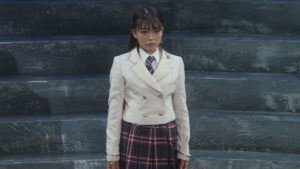 It’s then that Karen’s childhood Hikari arrives as a transfer student from a more prestigious school in London and helps save the day. Karen is thrilled to see her old friend again, but Hikari doesn’t seem to share the same enthusiasm. Eight of the nine soon receive a text message inviting them to special Revue auditions. The only one to not receive the message is the energetic but lazy Karen!
It’s then that Karen’s childhood Hikari arrives as a transfer student from a more prestigious school in London and helps save the day. Karen is thrilled to see her old friend again, but Hikari doesn’t seem to share the same enthusiasm. Eight of the nine soon receive a text message inviting them to special Revue auditions. The only one to not receive the message is the energetic but lazy Karen!
In the auditions, we see character pitted against character in one on one stage combat. Each girl transforms on stage into a military dress uniform and each uses a unique weapon from swords to daggers to even a bow to try and prove that they have more stage presence than their rival. These multiple ongoing battles are a lot of fun, and there’s some cool partially transparent panels set on wheels that are moved around the stage during this part to segment off and highlight the multiple concurrent battles. I thought this part was pretty clever and pretty well done.
 Ultimately, it’s Karen who wants to be friends with everyone who helps unify her class into working together. As partners, the girls put on one last musical combat spectacle as they work together to defeat the chorus. At the very end, the 99th class properly welcomes newcomer Hikari into their ranks, and everything ends happily.
Ultimately, it’s Karen who wants to be friends with everyone who helps unify her class into working together. As partners, the girls put on one last musical combat spectacle as they work together to defeat the chorus. At the very end, the 99th class properly welcomes newcomer Hikari into their ranks, and everything ends happily.
And then the second half of the show starts! You see, this whole event is broken up into the first half, which is a musical stage play that tells a complete story, and the second half, which is a more traditional idol style song and dance performance that’s just one song after another with no plot in between. Some of the songs are certainly catchy, and the dancing and movements are decent, there’s just not as much to say about this second half. You kinda just have to experience the songs for yourself.
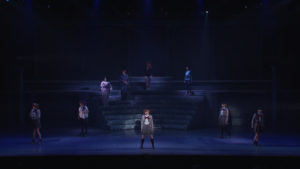 My favorite song in either half of the performance was “Watashitachi no Iru Riyuu” (The Reason We Are Here), which is actually a song that showed up a year later in the anime as “The Star Knows”. The anime version is a duet between Karen and Junna during their big Revue battle. In the stage play, it’s an ensemble song that shifts between each of the nine girls. The first half of the song is slower backed by a powerful piano and string solos. Each of the girls, in turn, sings about why they are stage girls. But, by the end, the song builds in tension and power as we learn that all the girls really have the same goal: they each want to find what makes them unique on stage. As it builds to a climax, percussion comes in and the song jumps quickly to each of the girls thoughts before unifying on them singing the same lines separately but together. It’s terrific!
My favorite song in either half of the performance was “Watashitachi no Iru Riyuu” (The Reason We Are Here), which is actually a song that showed up a year later in the anime as “The Star Knows”. The anime version is a duet between Karen and Junna during their big Revue battle. In the stage play, it’s an ensemble song that shifts between each of the nine girls. The first half of the song is slower backed by a powerful piano and string solos. Each of the girls, in turn, sings about why they are stage girls. But, by the end, the song builds in tension and power as we learn that all the girls really have the same goal: they each want to find what makes them unique on stage. As it builds to a climax, percussion comes in and the song jumps quickly to each of the girls thoughts before unifying on them singing the same lines separately but together. It’s terrific!
I like the Junna / Karen version in the anime since it’s really the first song that reveals the shape of the rest of the show, but I really, really love the song here in live action for it’s great little character moments and powerful conclusion.
 But it’s certainly not the only good song in the play. The earlier “Position Zero e!” Is a fun, upbeat number about the girls activities and goals at the music academy. “Star Divine”, which also appears in the anime as the climatic battle song, serves roughly the same purpose on the live action stage as the big number showing the girls shining together as a team. Finally, the second half of the event kicks off with an upbeat version of a fantastic song called “The Knowledge of a Stage Girl” which was later used in the anime. The animated version is a slow, happy reflection of what it means to be a stage girl. The live action version is considerably faster and more energetic and is used to get the crowd excited for the second half of the show. I like both versions a lot!
But it’s certainly not the only good song in the play. The earlier “Position Zero e!” Is a fun, upbeat number about the girls activities and goals at the music academy. “Star Divine”, which also appears in the anime as the climatic battle song, serves roughly the same purpose on the live action stage as the big number showing the girls shining together as a team. Finally, the second half of the event kicks off with an upbeat version of a fantastic song called “The Knowledge of a Stage Girl” which was later used in the anime. The animated version is a slow, happy reflection of what it means to be a stage girl. The live action version is considerably faster and more energetic and is used to get the crowd excited for the second half of the show. I like both versions a lot!
One final thing I’d like to address is what order this live action stage play and the anime should be watched in. They share a lot of similarities in characters and plot, but they are two distinct things. Ultimately, I think the anime should be watched first. Mostly, because since it has more time to tell its stories, there is more there to be spoiled. There’s a few instances in the stage play that reveal one character’s desires and those same desires play a much larger expanded role in the anime. Not knowing this character’s true desire is a key plot point of the anime, in fact. So, just for that reason alone, I’d recommend the anime first. I also liked having the anime depictions of the characters in my head as I watched the stage girls play the same parts. This isn’t so strange, I don’t think, because the anime version of each character gets a very brief appearance projected on stage during each of the live action girls’ short intros.
All In All:
 I thought the stage play was great. Each actress stuck to their character well. Each of them had something to do even if they weren’t currently under the spotlight. And, the songs often gave each character a chance to contribute and further highlight their personality. I’d probably give highest marks to the actress who had to physically embody the energetic yet timid Mahiru. Her jittery, smiley performance was very well done. The stage combat was pretty good with slashes and sword locks all supported by clanging sound effects. I’d rate this live action version of Revue Starlight a success. Its core story is somewhat different from the anime that came later, which I’ll talk about more in the Dig Deeper section, but is still strong in its own right even given the much more limited time the play had to work with.
I thought the stage play was great. Each actress stuck to their character well. Each of them had something to do even if they weren’t currently under the spotlight. And, the songs often gave each character a chance to contribute and further highlight their personality. I’d probably give highest marks to the actress who had to physically embody the energetic yet timid Mahiru. Her jittery, smiley performance was very well done. The stage combat was pretty good with slashes and sword locks all supported by clanging sound effects. I’d rate this live action version of Revue Starlight a success. Its core story is somewhat different from the anime that came later, which I’ll talk about more in the Dig Deeper section, but is still strong in its own right even given the much more limited time the play had to work with.
As Claudine Saijo might say: It was très bon!
Now that we’ve covered “was the play good and worth watching”, I’d like to dive into the specific similarities and differences between it and the anime. I’d say that the live action stage play and the anime are telling the same basic story. In both, Karen and Hikari become enamored by the play “Starlight” that they saw together as children and make a promise to one day become stars together. In both, Karen is too lazy to be invited to the Revues and Hikari transfers in devoid of passion because of a past defeat. All the other characters have extremely similar personalities and wishes and desires. The live action play has the stage girls act a little bit more antagonistic towards each other, but that’s resolved by the end of the play.
The biggest difference between the two are just how much more time the anime has to work with. Somethings that can be a quick song lyrics or lines of dialogue in the stage play are expanded to full episodes of the anime. I think it’s pretty clear that the stage play and anime were developed side by side, because those expanded storylines fit in great.
These changes do have some real impacts on the way the different stories flow:
- In the stage play, Futaba and Kaoruko’s fight is interesting because Kaoruko is pretty much in charge the entire time. She knows and recognizes that Futaba is the better stage performer so she uses her own superior acting ability to distract Futaba and get in a sucker punch of a final blow. The anime also has something of this, where Kaoruko tricks Futaba into closing the distance, but it is much more pronounced in the stage play. It’s also important to note that in the stage play, the two’s Revue battle harms their relationship somewhat, while in the anime, their Revue battle both improves Kaoruko’s work ethic and mends her relationship with Futaba.
- In the stage play, we only get one line about why Hikari returned. That maybe she’d been beaten in London and had to come crawling back. The anime shows us that entire series of events. What was a one line explanation in the stage play was turned into one of the biggest core plot points in the entire anime. That’s pretty cool.
- Likewise, the anime greatly expanded Banana’s role to the point that, really, three out of the twelve episodes focus on her while she was just a minor character in the stage play. Hearing live action Banana sing about not wanting to grow up and wishing time would stand still is actually pretty chilling coming from the anime where she straight up put her entire class, if not the entire world, into a time loop specifically so she could relive her class’ first performance of Starlight. Banana planning on repeating the loop is so well integrated into even the early episodes of the anime that I think it would be a shame to tip viewers off with some of the things she sings about in the stage play.
- Finally, any school staff we see in the anime are completely unaware of the Revues, but in the stage play the head of the academy is under orders from the giraffe to pit the girls against one another. This makes even the giraffe a more malevolent character than he is in the anime. He also only appears at the end of the stage play, so he’s quite a bit more mysterious, as well.
I think it’s great to have both versions of the story. It’s great to see a single good story told in different ways that are remolded to better support the medium they are being told in.
Review: Steins;Gate Anime
In Short:
Steins;Gate is a 2011 anime by White Fox that follows the humor and tragedy of self-proclaimed mad scientist Okabe Rintaro as he, and his friends, get in over their heads when they accidentally create a time machine by hooking up a cellphone to a microwave. Steins;Gate features great characters, witty dialogue, one of the better time travel plots around, and easily one of the best English dubs in all of anime.
Steins;Gate has a unique, desaturated art style that may not sit well with anime fans used to more colorful works. It is also one anime where you cannot use the “three episode rule” to determine its quality. Instead, it takes nearly twelve episodes for it to put all its pieces on the board. But, once it is finally ready, it goes all out for a thrilling, non-stop second half.
Suggested Minimum Watch: 3 episodes. You can’t give up on the show until Kurisu is made a lab member. But really, you should watch till episode 12…
Full Review:
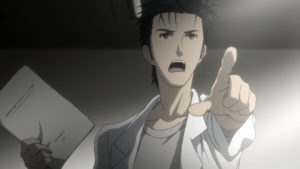 Okabe Rintaro, or “Hououin Kyouma” as he prefers to call himself just because it sounds cooler, likes to pretend he is constantly engaged in a secretive, high stakes battle for the future of humanity against a fictional group he calls “The Organization”. He often speaks in a grandiose, self-important tone, deflects scrutiny away from himself by pretending to get urgent phone calls as if he is a secret agent, and he likes to assign meaningless norse code names to his mundane tasks and projects as if he really is the mad scientist he claims to be.
Okabe Rintaro, or “Hououin Kyouma” as he prefers to call himself just because it sounds cooler, likes to pretend he is constantly engaged in a secretive, high stakes battle for the future of humanity against a fictional group he calls “The Organization”. He often speaks in a grandiose, self-important tone, deflects scrutiny away from himself by pretending to get urgent phone calls as if he is a secret agent, and he likes to assign meaningless norse code names to his mundane tasks and projects as if he really is the mad scientist he claims to be.
In reality, Okabe is an intelligent, if slightly eccentric, university student with a decent sense of humor who lives in a tiny second floor apartment which which he calls the Future Gadget Labratory. He and his best friend, computer hacker and fellow student Itaru “Daru” Hashida, frequently hang out together and come up with silly inventions in their spare time. Although he can in no way be called normal, Okabe mostly keeps up his mad scientist act for the benefit and delight of his childhood friend Mayuri Shiina.
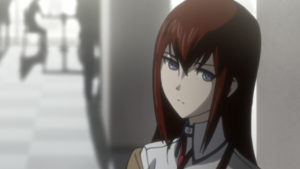 One day, while attending a lecture on the possibility of time travel, Okabe is pulled out into a hallway by genius university student Makise Kurisu. Strangely, Makise demands to know what Okabe wanted to tell her earlier… which is odd because Okabe has never spoken to her before in his life. Stranger still, just minutes later, Makise later ends up lying dead in a pool of her own blood at that same conference! But, strangest of all, is that everything seems to shift when Okabe texts news of Makise’s murder to Daru. Okabe soon finds out that the events of the past day have drastically changed. In this new timeline, Makise is still very much alive. In fact, she is the one now holding a talk on the impossibility of time travel.
One day, while attending a lecture on the possibility of time travel, Okabe is pulled out into a hallway by genius university student Makise Kurisu. Strangely, Makise demands to know what Okabe wanted to tell her earlier… which is odd because Okabe has never spoken to her before in his life. Stranger still, just minutes later, Makise later ends up lying dead in a pool of her own blood at that same conference! But, strangest of all, is that everything seems to shift when Okabe texts news of Makise’s murder to Daru. Okabe soon finds out that the events of the past day have drastically changed. In this new timeline, Makise is still very much alive. In fact, she is the one now holding a talk on the impossibility of time travel.
Makise and Okabe verbally spar over time travel theories at the lecture with Okabe coming out on the losing end. But still, Makise is intrigued enough by Okabe’s claims saying time travel is possible that she comes to visit him at his Future Gadget Laboratory apartment. Though the two frequently argue and spar and tease each other endlessly, they are both dedicated to the pursuit of science and actually hit it off fairly well despite a rocky start. The way these two characters interact is just brilliant and becomes even more so as the show moves into its non-stop second half. A scene where the more serious Makise at one point imitates Okabe’s eccentric mannerisms is easily a top highlight of the show.
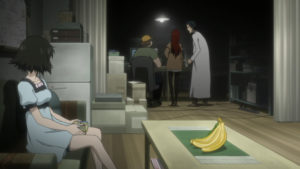 And that brings us to pacing. Steins;Gate is somewhat known for its slow start, and for good reason. For the first three or four episodes, you’re kinda left wondering if this time travel thing the show seems to be built around is even real. And, if it is real, will it ever be consequential enough to carry a twenty four episode series? The constant setbacks and limited time travel successes Okabe and friends achieve with their strange cellphone activated microwave almost leads you to believe that Steins;Gate is going to be about the boring, unimportant subtleties of time travel. But that’s not the case at all!
And that brings us to pacing. Steins;Gate is somewhat known for its slow start, and for good reason. For the first three or four episodes, you’re kinda left wondering if this time travel thing the show seems to be built around is even real. And, if it is real, will it ever be consequential enough to carry a twenty four episode series? The constant setbacks and limited time travel successes Okabe and friends achieve with their strange cellphone activated microwave almost leads you to believe that Steins;Gate is going to be about the boring, unimportant subtleties of time travel. But that’s not the case at all!
Every episode in the first half of Steins;Gate is packed with good character moments and interesting plot developments, even when those developments are occasional subtle. As an example, Okabe and friends at one point early on try to prove they can send messages back in time by attempting to win the previous day’s lottery. It’s a classic time travel trope. And their plan works… except the person they send the winning lottery numbers to gets them mixed up and they don’t end up winning after all. That’s the sort of thing that keeps occurring in the first half of Steins;Gate. Except it’s not the whole story.
 The closer Steins;Gate gets to it’s half way point, the more show ratchets up it’s level of tension. Things that seem innocent or incidental at first keep becoming more and more important and keep intruding more and more on the somewhat leisurely flow of the plot. Little by little, the story starts to accelerate, and you do start to see major consequences caused by Okabe’s meddling in time travel. By the time you reach the halfway point you know something big is going to happen. And then it does. And from then on the show’s pace changes from lazily drifting down a stream to battling the toughest white water river rapids imaginable. You quickly come to realize that the first half of the show was like the long slow pull up the first big hill of a roller coaster. Once you get to the top, the show doesn’t stop and doesn’t let up until it puts you through a series of thrilling high speed loops and drops and turns that continue all the way to the end.
The closer Steins;Gate gets to it’s half way point, the more show ratchets up it’s level of tension. Things that seem innocent or incidental at first keep becoming more and more important and keep intruding more and more on the somewhat leisurely flow of the plot. Little by little, the story starts to accelerate, and you do start to see major consequences caused by Okabe’s meddling in time travel. By the time you reach the halfway point you know something big is going to happen. And then it does. And from then on the show’s pace changes from lazily drifting down a stream to battling the toughest white water river rapids imaginable. You quickly come to realize that the first half of the show was like the long slow pull up the first big hill of a roller coaster. Once you get to the top, the show doesn’t stop and doesn’t let up until it puts you through a series of thrilling high speed loops and drops and turns that continue all the way to the end.
If it’s solid, exciting time travel plot is one of Steins;Gate’s strengths, its characters are its other strong point.
Okabe plays the role of pretend mad scientist with equal parts charm and delusion. He’s really not so out of the ordinary when he occasionally drops out of his crazier persona, but when he is fully in his role as mad scientist Hououin Kyouma, he can be quite egotistical and infuriating to his friends.
Daru plays a great straight man to Okabe’s mad scientist, but he can be just as wacky as Okabe thanks to his occasional semi-lewd observations and his devotion to his online video game character harem that he has to keep up with.
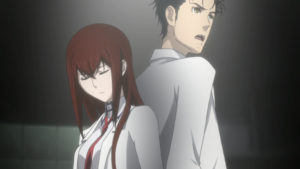 Then there’s Makise who really is the show’s second main character. She is intelligent and witty and is constantly verbally sparing with the goofier Okabe over everything from legitimate scientific theory to how bad she is at cooking. One of the funnest things about Makise is she’s just as much of a nerd as Okabe and Daru are, but unlike them, she does her best to keep that fact hidden. Her attempts to hide her knowledge of nerd culture lead to some of the best lines of dialogue in the series, and Okabe’s teasing, antagonistic love/hate relationship with her is a highlight of the show.
Then there’s Makise who really is the show’s second main character. She is intelligent and witty and is constantly verbally sparing with the goofier Okabe over everything from legitimate scientific theory to how bad she is at cooking. One of the funnest things about Makise is she’s just as much of a nerd as Okabe and Daru are, but unlike them, she does her best to keep that fact hidden. Her attempts to hide her knowledge of nerd culture lead to some of the best lines of dialogue in the series, and Okabe’s teasing, antagonistic love/hate relationship with her is a highlight of the show.
Steins;Gate also has a small cast of interesting characters who help or hinder Okabe in various ways. The stories of these seemingly minor characters are a lot more personal and fleshed out than you might expect, and actually play a larger role in the main story than you might at first think. There are some great, weighty moments that I don’t want to spoil, but check out the Dig Deeper section below if you are interested in learning more about these side stories and why they are included alongside the main plot.
 One final thing that makes Steins;Gate’s story so good is that it pulls in a lot of real world elements and twists them around for its own fictional purposes. For instance, time traveler John Titor actual was the originator of the time travel theories that the lecturer plagiarized at the beginning of the first episode. “John Titor” was a real username who posted on message boards about time travel back in 2001. Likewise SERN, a misspelling of the real world CERN, better known as the European Organization for Nuclear Research is a real world group of scientists who do high energy particle physics. Their fictional counterparts play a major role in Steins;Gate and help make the show feel more grounded in reality than it otherwise would.
One final thing that makes Steins;Gate’s story so good is that it pulls in a lot of real world elements and twists them around for its own fictional purposes. For instance, time traveler John Titor actual was the originator of the time travel theories that the lecturer plagiarized at the beginning of the first episode. “John Titor” was a real username who posted on message boards about time travel back in 2001. Likewise SERN, a misspelling of the real world CERN, better known as the European Organization for Nuclear Research is a real world group of scientists who do high energy particle physics. Their fictional counterparts play a major role in Steins;Gate and help make the show feel more grounded in reality than it otherwise would.
Graphics & Sound
 Graphically, Steins;Gate is… different. It has plenty of detail in its characters and backgrounds, and while it’s by no means an animation powerhouse, it gets by well enough. What makes it a little odd is its palette and style that sorta sucks the color out of most of its scenes. Indoors, this mostly just means that a lot of the colors, especially the background colors, are somewhat muted. But outdoors, the show often combines its subdued colors with bright glare meant to convey the heat of summer. This subdued but also blown-out look was a little distracting to me at first and took a while to get used to. I wouldn’t even say its unique style is used to any great effect. It simply is what it is and you can like it or not. Personally, I kinda don’t.
Graphically, Steins;Gate is… different. It has plenty of detail in its characters and backgrounds, and while it’s by no means an animation powerhouse, it gets by well enough. What makes it a little odd is its palette and style that sorta sucks the color out of most of its scenes. Indoors, this mostly just means that a lot of the colors, especially the background colors, are somewhat muted. But outdoors, the show often combines its subdued colors with bright glare meant to convey the heat of summer. This subdued but also blown-out look was a little distracting to me at first and took a while to get used to. I wouldn’t even say its unique style is used to any great effect. It simply is what it is and you can like it or not. Personally, I kinda don’t.
Where Steins;Gate shines, however, is in its dialogue and voice acting. It’s fine in Japanese, and there’s some great moments like Okabe’s odd broken English greeting to a back alley vendor, but I will probably never watch it in Japanese again because the show is stellar in English. Steins;Gate is one of maybe five anime that I’ll hold up as incontrovertibly better in English than they are in Japanese. In either language, Steins;Gate’s dialogue is fast paced and witty, but in English, Funimation both provided great voice actors and made some substantial changes to the dialogue to make it flow better for an English audience.
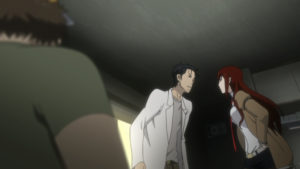 What this means is, the English dialogue and acting in Steins;Gate is among the best of the best. Conversations flow brilliantly and you can hear every emotion the characters are conveying. But it also means that English dub is very decidedly not a direct translation. If that matters to you, by all means stick to the Japanese. In most places, this is wonderful. In episode 9, for instance, the English dub swaps out a confusing joke about @channel (Steins;Gate’s in-universe version of Twitter) for a trio of sly references to Star Trek. This kind of thing happens throughout the series. The English dub never changes the intent of the characters and it doesn’t at all alter the plot, but individual words, sentences, and exchanges can and do sometimes end up a bit different in the English version than they were in Japanese.
What this means is, the English dialogue and acting in Steins;Gate is among the best of the best. Conversations flow brilliantly and you can hear every emotion the characters are conveying. But it also means that English dub is very decidedly not a direct translation. If that matters to you, by all means stick to the Japanese. In most places, this is wonderful. In episode 9, for instance, the English dub swaps out a confusing joke about @channel (Steins;Gate’s in-universe version of Twitter) for a trio of sly references to Star Trek. This kind of thing happens throughout the series. The English dub never changes the intent of the characters and it doesn’t at all alter the plot, but individual words, sentences, and exchanges can and do sometimes end up a bit different in the English version than they were in Japanese.
There’s not a lot to talk about in terms of music for Steins;Gate. There is some music, I guess, during tense or important scenes, but I can hardly recall it. What did stand out to me, though, was its opening theme. “Hacking to the Gate” is upbeat and relevant to the plot without being any kind of direct spoiler. I still listen to it on occasion, but this is not a show where I picked up the full instrumental score like I do for some of my other favorites.
All In All:
Steins;Gate is one of my favorite anime of all time. Its combination of great characters, fantastic witty dialogue, and a very strong time travel plot kinda checked all the boxes for me. Yes, it’s a little slow in the beginning, but rest assured that things really do build on themselves and pick up as the show approaches the half-way mark. Steins;Gate has tension, and emotion, and excitement to spare, it simply doesn’t show its full hand nearly as quickly as some other shows. But once it does hit its proverbial 88 miles per hour, you will, indeed, see some serious shit! (What?! I had to get a Back to the Future reference in there somewhere!)
Steins;Gate’s Visual Novel Influences:
One of the interesting points that I kinda feel is necessary to fully understanding Steins;Gate – the anime – is that it was based upon Steins;Gate – the visual novel. For those that don’t know, Visual Novels are a popular type of role playing game in Japan. In them, you typically play a lead character in a story and you travel around various locations in an area such as a town and have branching conversations with several other characters. But it’s almost all presented in fixed screens and backgrounds and unmoving character art instead of in 3d like an open world game. Visual Novels often have several different endings depending on who you talk to and what what you say to them and what dramatic choices you make.
Steins;Gate is one of the better known Visual Novels, but there are other anime based on Visual Novels you might recognize. For instance, Fate/stay night was also originally a Visual Novel. In the Steins;Gate game, you played as Okabe and, along with talking to the characters represented in the anime, you could also receive text messages from the future where acting on them was critical to get one of the better endings. To get the best ending, which is basically the one depicted in the anime, you almost had to replay the game multiple times so you could act on information you learned during your previous failures.
Steins;Gate’s original form being a Visual Novel also plays into some of the anime’s plot choices. The various one off episodes where Okabe spends time with each of the girls and rolls back their altered futures comes directly from the Visual Novel. Depending on your choices Okabe could end up paired off with any one of the girls in one of the game’s multiple good endings. Or he could end up dead in various ways in the game’s multiple bad endings. The anime pays respect to that by working in most of those sub stories that were mutually exclusive from each other. You actually had to play the game several times to see each of the endings.
In the anime, I thought this worked fine, but it does shed a little light on why the anime seemed to string a few side stories together and made them critical to progressing the main story of saving Mayuri and Makise.
The Almost Perfect Time Travel Plot:
Out of all the time travel shows and movies I’ve seen, I think Steins;Gate has one of the best, most consistent time travel plots out there. All the pieces fit into place across several timelines and several failed attempts to set things right… except one thing. I’ve never been able to justify the video Okabe gets from himself being static the first time he looks at it. Oh, the justification in the show is fun and clever… that it was locked or inaccessible until he moved onto the worldine where he killed Makise, or some such thing. But how does that make any sense? I think it would have been better if he’d never looked at the video of if it had been slow to download so he didn’t have time to look at it before he had to rush to see Makise seemingly dead in the hallway. The way it is now, it feels like the one puzzle piece that doesn’t fit into the great time travel plot.
Review: Land of the Lustrous Anime
In Short:
Land of the Lustrous is a 2017 anime by CGI powerhouse Orange about a small group of immortal, genderless people whose entire bodies are made of the gemstone or mineral each is named after. While most of the gems, like Jade or Diamond, are content to carry out their same routines day after day, just as they have for hundreds or even thousands of years, the show’s focus on the spunky but naive and physically brittle Phosphophyllite rewards viewers with one of anime’s best character arcs.
For better or worse, the anime only covers the first few chapters of the manga it is based on. So, while Land of the Lustrous tells an interesting story filled with great characters, some spectacular combat, and a deft combination of fun humor and intense drama, it does end just when it seems the real story is about to begin.
Suggested Minimum Watch: 2 episodes. It would be a big shame to quit the show before you get to meet Dia and Bort.
Full Review:
Land of the Lustrous (houseki no kuni) is one of those rare anime that requires a lot more explanation than usual simply because its setting is so different from anything else out there. It’s not set in a high school, or on a military space ship, or a sports field, or really anywhere else your typical anime is.
 At its simplest, Land of the Lustrous is an anime about a group of immortal sentient humanoid gemstones living together on an otherwise uninhabited grassy island. The gems are primarily organized by their hardness, durability, and personality. The green haired Jade, for instance, is logical and factual and serves the role as the group’s day to day organizer. Bort, with its long black hair and cold, demanding demeanor is the most durable of all the gems and so it serves as their most potent defender. Other gems take on a variety of roles from lookouts to gathers to even a clothing designer and a surgeon of sorts.
At its simplest, Land of the Lustrous is an anime about a group of immortal sentient humanoid gemstones living together on an otherwise uninhabited grassy island. The gems are primarily organized by their hardness, durability, and personality. The green haired Jade, for instance, is logical and factual and serves the role as the group’s day to day organizer. Bort, with its long black hair and cold, demanding demeanor is the most durable of all the gems and so it serves as their most potent defender. Other gems take on a variety of roles from lookouts to gathers to even a clothing designer and a surgeon of sorts.
The gems do not age and cannot really die. They essentially just lose consciousness if sufficiently dismembered, but even if they are shattered by an accident or by an attack, they can always be pieced back together and wake up good as new. They don’t breath, so operating underwater is not much of a hinderance. They don’t eat, per say, since they get their nourishment and energy from the sun, so even food is mostly a non-issue for them. It does mean that they tire easily at night to the point of sometimes falling asleep unintentionally, and that they spend the long cloudy winters in hibernation, but they can, with effort, stay awake, so even those actions are more an inconvenience than an outright limitation. The gems also store their memories all throughout their bodies instead of just in a brain. This means that if they are shattered but not put completely back together they can forget things they once knew. But, since they are immortal, it is rare for them not to be able to track down all the pieces of one of their companions.
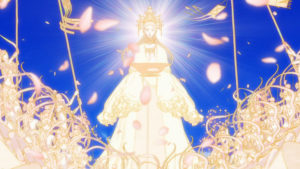 The only true enemy the gems have are the show’s second set of strange, otherworldly creatures: the Lunarians. Their sole goal appears to be to shatter the gems and cart them back off to the moon for some unknown purpose. Each time they appear, they emerge in the sky out of what looks to be strange ink blots that open to reveal a small army riding on a large yellow disc of clouds that hovers above the island. These raiding parties are armed with bows and spears, but they almost seem more ritualistic than warlike, as roughly half the Lunarians in each raid come playing drums, tambourines, or flutes, while others hold flags and banners. If anything, the Lunarians appear to be based in Budist imagery. Interestingly, the Lunarians appear to be made of clouds themselves. They are the same yellow color as the clouds they ride on and they blow away when defeated.
The only true enemy the gems have are the show’s second set of strange, otherworldly creatures: the Lunarians. Their sole goal appears to be to shatter the gems and cart them back off to the moon for some unknown purpose. Each time they appear, they emerge in the sky out of what looks to be strange ink blots that open to reveal a small army riding on a large yellow disc of clouds that hovers above the island. These raiding parties are armed with bows and spears, but they almost seem more ritualistic than warlike, as roughly half the Lunarians in each raid come playing drums, tambourines, or flutes, while others hold flags and banners. If anything, the Lunarians appear to be based in Budist imagery. Interestingly, the Lunarians appear to be made of clouds themselves. They are the same yellow color as the clouds they ride on and they blow away when defeated.
For the most part, the gems are content to live their immortal lives doing the same thing day in and day out for years, decades, centuries, and even millennia at a time. Although there are some, like the doctor Rutile, who show curiosity in their specific fields of expertise, it seems pretty clear that the gems are not especially inquisitive and prefer to simply carry out the roles given to them by their leader, Sensei Kongo.
But then there’s Phos.
 Phos, short for Phosphophyllite, is a brittle, easily cracked peppermint green gem who bears the distinction of being the only one of the gems to not have an assigned task. Phos is upbeat, happy, energetic, and spunky. It is also clumsy, prone to complaining and talking back, and more than a little inattentive. For the first nearly 300 years of its life, Phos has just lounged around in the sun doing little more than occasionally annoying its fellow gems. In all that time, Sensei Kongo has been trying to find a task that the short attention spanned and easily broken Phos can carryout without wandering off or being shattered. Phos seems to be a poor choice for any sort of repetitive task, and even though they wish to take part in what they naively see as the glamour and excitement of combat against the Lunarians, they are far too fragile to do so.
Phos, short for Phosphophyllite, is a brittle, easily cracked peppermint green gem who bears the distinction of being the only one of the gems to not have an assigned task. Phos is upbeat, happy, energetic, and spunky. It is also clumsy, prone to complaining and talking back, and more than a little inattentive. For the first nearly 300 years of its life, Phos has just lounged around in the sun doing little more than occasionally annoying its fellow gems. In all that time, Sensei Kongo has been trying to find a task that the short attention spanned and easily broken Phos can carryout without wandering off or being shattered. Phos seems to be a poor choice for any sort of repetitive task, and even though they wish to take part in what they naively see as the glamour and excitement of combat against the Lunarians, they are far too fragile to do so.
Phos is the lead character of the show, and deservedly so. Early on, it is tasked by Sensei Kongo to compile an encyclopedia for the other gems. It immediately tries to find a way out of the job either by getting others to fill in for it, or by at least roping one of the other gems in as an assistant. In the early episodes, Phos’ wit and spunk shine, filling each scene with humor and laughs. Land of the Lustrous could have easily padded out its twelve episodes with Phos’ delightfully dismissive antics, but it goes far above and beyond that. Where this could have been a show of nothing but humor, Land of the Lustrous is actually more an examination of tragedy and change, with most of that change happening to Phos itself. One of the strongest points of the show is the arc Phos goes through. The Phos we see by the end of the twelfth episode is a far different character than the Phos we get in episode one.
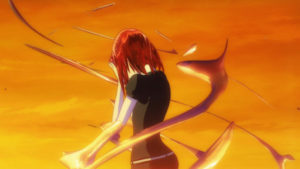 Phos’ journey is set in motion by Cinnabar, a second oddity among the gems. Where most of the gems, including Phos, live together on the island, Cinnabar lives alone away from the others by its own choice. Cinnabar, you see, is literally toxic to the plants and animals of the island thanks to the never ending flow of mercury it exudes. This mercury is even dangerous to the other gems as it can damage their finish and prevent them from absorbing the sun’s rays. Early on, Phos hears that Cinnabar is very clever, so it tries to rope Cinnabar into its encyclopedia task only to learn Cinnabar has a tragic secret.
Phos’ journey is set in motion by Cinnabar, a second oddity among the gems. Where most of the gems, including Phos, live together on the island, Cinnabar lives alone away from the others by its own choice. Cinnabar, you see, is literally toxic to the plants and animals of the island thanks to the never ending flow of mercury it exudes. This mercury is even dangerous to the other gems as it can damage their finish and prevent them from absorbing the sun’s rays. Early on, Phos hears that Cinnabar is very clever, so it tries to rope Cinnabar into its encyclopedia task only to learn Cinnabar has a tragic secret.
Although Cinnabar is tasked with performing the night watch for the other gems thanks to the way its mercury lets it live off starlight, this tasks is actually pointless and futile. The Lunarians have never once, in several thousands years, appeared after sundown. When Phos finally meets Cinnabar, the latter admits it would welcome being incapacitated and taken away to the moon if only to end its monotony and isolation. Day after day and night after night Cinnabar stands waiting for the Lunarians to come for it, yet, for some reason, they never do. That it isn’t even desired by the Lunarians only serves to push Cinnabar into further self-loathing.
 When Phos learns of this shocking, bitter secret, it makes a hasty yet sincere promise to Cinnabar to find them a better job than the night watch. To find Cinnabar a job that only it can do. This heartfelt promise from the flighty Phos, who has likely never promised anyone anything like this before, drives much of the plot throughout the rest of the show.
When Phos learns of this shocking, bitter secret, it makes a hasty yet sincere promise to Cinnabar to find them a better job than the night watch. To find Cinnabar a job that only it can do. This heartfelt promise from the flighty Phos, who has likely never promised anyone anything like this before, drives much of the plot throughout the rest of the show.
Graphics & Sound
One of the first things you often hear about Land of the Lustrous is how it is computer animated. This is a rather divisive issue among anime fans as 3d computer animated shows are often thought to be more clunky and less fluid and expressive than 2d hand drawn shows. Land of the Lustrous got around these problems by taking the best of both worlds. Orange brought in noted 2d animators to help with storyboarding and combat scenes. They would sometimes literally draw expressive line art on top of the unfinished computer animations to give the computer animators tips and goals to shoot for, ensuring that the show remained just as expressive as the best hand drawn anime.
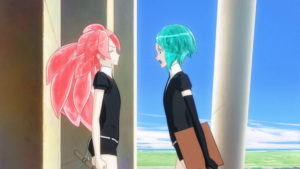 Orange also recorded the voice actors first and did the animations second. This is opposite of the way most 2d and 3d anime are done. By recording the voices first, it gives the animators something to work off of. They were able to time movements and invent new animations that added fluidity in time with each characters’ already recorded voices. The end results is that Land of the Lustrous has an extra level of snappiness and expression that you don’t often get in anime.
Orange also recorded the voice actors first and did the animations second. This is opposite of the way most 2d and 3d anime are done. By recording the voices first, it gives the animators something to work off of. They were able to time movements and invent new animations that added fluidity in time with each characters’ already recorded voices. The end results is that Land of the Lustrous has an extra level of snappiness and expression that you don’t often get in anime.
But beyond all that, the show is just beautiful! Land of the Lustrous makes brilliant use of lighting and color. The island the gems live on is detailed and scenic from its wave-swept beaches to its marshy forests to the two white stone structures the gems live in. It had me captivated by the very first blade of green grass that came on the screen.
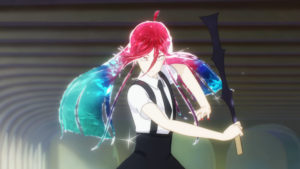 Each gem looks spectacular, as well, with their own diverse styles and colors of translucent hair that casts light on nearby objects and environments. One of my favorite visual tricks the show pulls is showing that the irises of each gem are, in fact, composed of a complex facet of gemstone shapes that appear whenever the camera gets close enough. The Lunarians, too, have such an interesting and creepy look to them that feels so different from everything else in the show. They have an entirely different visual style that can at times be awe inspiring.
Each gem looks spectacular, as well, with their own diverse styles and colors of translucent hair that casts light on nearby objects and environments. One of my favorite visual tricks the show pulls is showing that the irises of each gem are, in fact, composed of a complex facet of gemstone shapes that appear whenever the camera gets close enough. The Lunarians, too, have such an interesting and creepy look to them that feels so different from everything else in the show. They have an entirely different visual style that can at times be awe inspiring.
A lot of the show’s general look and feel comes from its manga. While the Land of the Lustrous anime is not a shot for shot recreation, it does take some of the best panels from the manga and mixes them up where necessary to make a more compelling tv show. This is a fine line to walk, as showing the same scene from a different angle could ruin it, but Orange pulled it off with room to spare. Check the Dig Deeper section below for some links to videos that go in-depth about the show’s visuals.
 On the audible front, I love this show’s sounds and music just as much as I love its colors and animation. There’s this great mix of piano and strings and horns and more exotic instruments that come together to create a wide variety of moods. Special call out goes to the chillingly strong piano notes of the main theme you get just seconds into starting the first episode.
On the audible front, I love this show’s sounds and music just as much as I love its colors and animation. There’s this great mix of piano and strings and horns and more exotic instruments that come together to create a wide variety of moods. Special call out goes to the chillingly strong piano notes of the main theme you get just seconds into starting the first episode.
I actually bought the soundtrack to this one like I do for all the anime whose music I love, and it’s been great to listen to Phosphophyllite’s upbeat, hopeful theme as well as the sad, worrisome, lonely theme provided to Cinnabar. Then, of course, there’s Sunspot, the strange theme filled with bells and tambourines that plays whenever the Lunarians appear. The battle theme, Battle, is great too!
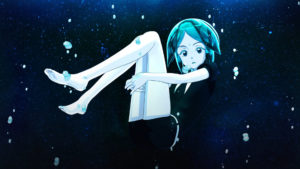 I also love the show’s opening. It has a complexity about both its graphics and audio that is entrancing. It’s also interesting because while Phos is the one who dominates the screen, the song itself appears to be sung by Cinnabar. Listen closely to the lyrics where the singer talks about being the only one to wander through the night. Those words don’t belong to Phos or any of the other gems!
I also love the show’s opening. It has a complexity about both its graphics and audio that is entrancing. It’s also interesting because while Phos is the one who dominates the screen, the song itself appears to be sung by Cinnabar. Listen closely to the lyrics where the singer talks about being the only one to wander through the night. Those words don’t belong to Phos or any of the other gems!
Finally, in regards to voice acting, Land of the Lustrous is excellent there as well. The Japanese cast did an amazing job bringing their respective characters to life. Phos’ voice actress, in particular, brings a ton of energy and fun to the character. The show’s English dub is also very good. The Japanese cast set a hard act to follow, but the English actors did a great job. I was a little afraid for the English dub just because of how fast paced and nuanced characters like Phos could be at times, but the English actors for Phos and the other gems matched those performances to my satisfaction.
All In All:
Land of the Lustrous is an interesting show that is unique even among other great anime. Its setting and concepts are delightfully alien while still being relatable. Its look, animation, and sound are excellent. And, its characters’ desires and motivations, especially those of its lead character Phos and secondary character Cinnabar, are complex in ways you may not expect from just watching the first episode.
Even though it tells an enjoyable story on a surface level, Land of the Lustrous is, in some ways, one of the most complex anime I’ve ever recommended. Its characters and their motivations are often pulled in opposite directions. The show itself has overarching and deeply rooted Buddhist themes. And, the show is bold enough to often have its characters greatest learning moments be their biggest failures. I may be a little scattered here, because there is so much to talk about, but let me share a few things that I think push Land of the Lustrous above and beyond.
One of my favorite parts of Land of the Lustrous is just how much Phos changes throughout the course of the show. The final episode has a great moment where Phos looks back at its past self, but there are some great moments along the way that made me love Phos all the more.
After Phos gets its new legs and its super speed, it joins the Amethyst twins and quickly finds out that joining the other gems out on patrol is not nearly as cools as it had hoped. It was great to see Phos spend the entire first day jumping at every little thing that happened. A few days later, we see that Phos has already grown tired of waiting. It was a neat demonstration on how sometimes the fantasy of a thing doesn’t match the reality.
Another great moment is when Phos is chasing down the Lunarians that are stealing away Antarcticite. Phos’ lines about overcoming its limits but still failing were unexpectedly powerful to me. In most other shows, Phos would have succeeded, having finally come to grips with the responsibility it owed its fellow gems, but that wasn’t the point here. I loved the way Land of the Lustrous used hope followed by further failure to grow Phos’ character.
Cinnabar also got some neat subtle moments. Throughout the series, Cinnabar all but refuses to interact with the other gems. Even when it could have stepped out of the shadows and alerted all the gems looking for Phos under the sea, it didn’t. Why not? It all comes back to Cinnabar’s true motivations for staying away.
Yes, Cinnabar was tired of being alone and terribly distraught at the way its poisonous mercury harmed and killed everything around it, but that wasn’t the real reason Cinnabar stayed away. Instead, listen again to what Cinnabar says in the first episode when it is complaining to itself about wanting to be free of the night. It also says that no, it can’t trust Phos.
For the longest time I forgot about that part. It seemed out of place and unimportant, until it was made clear that Cinnabar didn’t trust Sensei Kongo and the other gems precisely for the same reasons as Phos is losing trust at the end of the series. Cinnabar had long ago determined that there was some link between Kongo and the Lunarians, but unlike the other gems who were mostly content to continue on with their lives, Cinnabar distanced itself from Kongo and thus the gems that he led. I love how this second layer gives Cinnabar’s actions so much more meaning once you realize what is going on.
Finally, there’s something I didn’t want to talk about in the main review. It’s that I’m actually happy that Land of the Lustrous has not gotten a second season. I kinda don’t want it to ever get another season even though it does end itself on a major cliffhanger. This is because I don’t like the direction the manga heads in. What I wanted to happen is for Cinnabar and Phos to join forces and solve the mystery of the Lunarians together. Things didn’t need to end perfectly happy, but I was happy with where Phos and Cinnabar ended up by the end of the season. I wanted to follow those characters through to their eventual conclusion.
That doesn’t happen.
Instead, the manga sees Phos get more and more pieces replaced, most notably its head. Phos actually gets taken to the moon where it communicates and joins forces with the Lunarians. Phos eventually sparks a kind of civil war between the gems back on earth. There’s also the revelation that the Lunarians were grinding the captured gems into dust and spreading them out on the surface of the moon because they wanted Kongo to see and agree to their demands. I would be fine with that except the manga then breaks the rule about the gems always being able to be put back together. It is said that any of the weaker gems spread out this way had their inclusions bleached away and were truly dead. This included Antarcticite, which made me very unhappy.
In general the manga sounds like it just gets more and more unhappy, to the point that an even more drastically changed Phos at one point demands that Sensei Kongo murder it because it cannot live with itself and what it has done. I will check back once the manga finishes. A good ending could very well be worth all the turmoil to get there. But for now, I don’t want to read most of what I’ve heard about and consequently, I don’t want to see it animated either.
As usual, I do have a few recommendations if you want to learn more about this anime:
- Land of the Lustrous: A PERFECT Adaptation This video goes in depth for a shot for shot, panel for panel look at how the anime followed and expanded on its manga’s lead to create a fantastically artistic visuals.
- What Makes a Soundtrack Great – Land of the Lustrous & What Makes Cinnabar’s Theme So Emotional (Let’s Talk About The Erhu) takes a look at the show’s music in general, and Cinnabar’s theme in particular.
- The most complex pop anime OP looks at the crazy musical timing of Land of the Lustrous’ opening song.
- Finally, if you really love the show like I do, I highly recommend Nearly On Red’s fantastic 10+ hour Episode by Episode Breakdown that goes all in on examining the show’s plot and characters. Note, that an episode 12 breakdown exist as a twitch livestream viewing of the twelfth episode and more than an hour of comments afterwards.
Review: Shoujo☆Kageki Revue Starlight Anime
In Short:
On its surface, Revue Starlight is an anime about nine young women who attend an all girls music and stage production school. They learn to sing and dance and act and perform as you might expect. But, when they aren’t attending academic or artistic classes, these same girls are called to fantastical Revue auditions where they must literally fight each other, weapons in hand, in thrilling, character revealing, one-on-one musical stage battles for the right to be their class’ Top Star.
Revue Starlight, to its credit, is built around a detailed, veiled criticism of the Takarazuka Revue style of stage shows and music schools, but some viewers may be unfamiliar with these real world contexts, leaving them lost to the show’s finer points.
Suggested Minimum Watch: 1 episode. The first episode encapsulates both the mundane slice of life and fantastical Revue sides of the show well enough to let you know what you’re getting into.
Full Review:
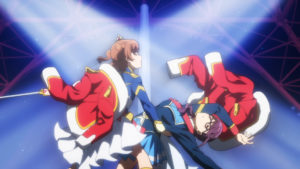 It was the stage battles of Revue Starlight that first caught my eye. They looked like something out of a Magical Girl anime with flashy transformations and superhuman movements. That the show also seemed to focus somewhat on the behind the scenes aspects of a performing arts training school interested me, as well, since I tend to enjoy anime that really know their real world influences. In some ways, I got a bit more than I bargained for as you’ll see in the Dig Deeper segment at the end!
It was the stage battles of Revue Starlight that first caught my eye. They looked like something out of a Magical Girl anime with flashy transformations and superhuman movements. That the show also seemed to focus somewhat on the behind the scenes aspects of a performing arts training school interested me, as well, since I tend to enjoy anime that really know their real world influences. In some ways, I got a bit more than I bargained for as you’ll see in the Dig Deeper segment at the end!
In the first episode, we are introduced to eight girls who attend Seisho Music Academy. They do everything together from attending typical academic classes to participating in all the different dance, acting, and performing arts classes you might find at a music academy. For the most part, the cast is split into pairs early on. Our main character, the energetic yet lazy Karen Ajio gets paired up with the more reserved and responsible Mahiru Tsuyuzaki. The most accomplished dancer and actress in the class, Maya Tendo, often gets paired off with her competitive rival the French-Japanese Claudine Saijo. And so it goes. Each of these pairings end up carrying through the anime’s twelve episodes with transfer student Hikari Kagura throwing a wrench into the balanced mix by the end of the first episode.
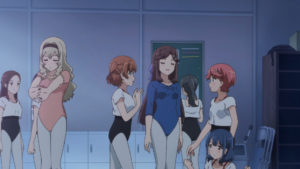 In and out of class, the girls are relatively friendly, but there is an air of competition between some of them that complicates things. Others have different personal issues that need to be worked through. For instance, elegant hometown star Kaoruko Hanayagi’s over reliance on her long time friend Futaba Isurugi eventually becomes an issue. There’s also the soft spoken but intelligent and hard working Junna Hoshimi and the capable but surprisingly motherly Nana Daiba who form a strong bond later in the series after a shared revelation.
In and out of class, the girls are relatively friendly, but there is an air of competition between some of them that complicates things. Others have different personal issues that need to be worked through. For instance, elegant hometown star Kaoruko Hanayagi’s over reliance on her long time friend Futaba Isurugi eventually becomes an issue. There’s also the soft spoken but intelligent and hard working Junna Hoshimi and the capable but surprisingly motherly Nana Daiba who form a strong bond later in the series after a shared revelation.
If Revue Starlight were merely a slice of life show focused solely on these girls and their preparations for their upcoming stage show “Starlight” it would passable but a little dull. All the characters are generally likable, and there are minor conflicts, but there’s just no intense spark between any of them that makes you sit up and take notice. That’s because the show is saving its biggest emotions and character moments for the stage.
At the end of each day of classes, most of the girls receive a strange text message with the cute icon of a giraffe inviting them to special Starlight Revues. The girls enter a not normally there elevator within the school and are brought down deep underground to a giant circular stage surrounded by an even larger pool of water all beneath a bizarrely underground version of Tokyo Tower. Here, their singing, acting, and combat abilities(?!) are pitted against one another in one on one stage battles.
These Revues make up the core strength of the show. They are fantastical and highly reflective of each’s girl’s almost magical stage presence. The Stage of Fate they fight on often shifts and changes in response to the current combatants’ deepest thoughts and desires, and in response to who currently has the upper hand in the performance. Backgrounds, which can be anything from brightly painted cardboard flames to abstract city sets, often magically move in and out as if part of a stage play. The girls themselves transform as if they’re part of a Magical Girl anime. They fight in fancy military dress uniforms instead of the clothes they are wearing when they arrive at each Revue.
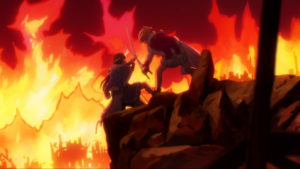 The girls clash their weapons and leap to impossible heights and dodge and tumble as part of these battles, but there is always a strong theatrical element involved. They move with a dancer’s grace and follow dramatic stage direction that sometimes even sees them coordinate their singing and dancing as if part of a stage musical. Despite the clang of weapons, there isn’t any actual violence in these Revues. I can’t remember even a single time that any of the girls actually get hurt in the several Revues they attend. Their goal isn’t to stab or maim their opponents. Instead, they try to cut the tie that holds their opponent’s cape-like overcoat on their shoulder so it falls to the ground.
The girls clash their weapons and leap to impossible heights and dodge and tumble as part of these battles, but there is always a strong theatrical element involved. They move with a dancer’s grace and follow dramatic stage direction that sometimes even sees them coordinate their singing and dancing as if part of a stage musical. Despite the clang of weapons, there isn’t any actual violence in these Revues. I can’t remember even a single time that any of the girls actually get hurt in the several Revues they attend. Their goal isn’t to stab or maim their opponents. Instead, they try to cut the tie that holds their opponent’s cape-like overcoat on their shoulder so it falls to the ground.
The Revues always feature two different girls paired off against each other, but the real thing keeping each Revue interesting is that they have a larger point than just seeing which girl is better with their chosen weapon. The Revues are not really about the physical combat at all. Instead, each Revue highlights the various girls’ interpersonal conflicts. One early Revue highlights how one of the girls came to see being on stage as a way to free herself from her childhood shyness and how her opponent’s newfound success threatens to take the shy girl’s stage, and confidence, away. Another Revue is squarely focused on demonstrating that one girl’s spirit and enthusiasm by themselves are not nearly enough to overcome another girl’s innate talent.
While these Starlight Revues are the heart of the show, Revue Starlight actually manages to tie its flashy combat back into its stage girls’ daily lives in interesting ways. The lessons about kindness, hard work, jealousy, and sacrifice the girls learn during their Revues often change them for the better off the stage. But, more than that, Revue Starlight tells a satisfyingly cohesive overall story with a couple of twists and turns along the way. I appreciate the way it broke up details about the Starlight Revues and about its characters’ motivations and backstories. You don’t learn everything all at once, but the pacing delivers new revelations almost on an episode by episode basis.
If I was to levy any criticism of the show’s plot, it’s that the school’s two top ranked stage girls, Maya and Claudine, don’t get the backstory episodes they deserve. Each has a big personality and have hints at compelling pasts, but we never dive in. And that’s a shame.
Oh, and I guess I should address the elephant in the room. Or, more specifically, the giraffe. These magical Revues are coordinated and overseen by a full-sized, deep-voiced, telepathic talking giraffe. It is the giraffe who introduces girls to the Revues and who sets the schedule for who battles who each day. Yes, his inclusion is strange, and while I don’t want to spoil everything about him, you should listen to what he says, as his plainly stated desires and love of the stage make up a small but important part of the show’s plot.
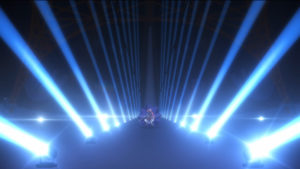 In terms of art and animation, Revue Starlight ranges from good to stunningly great. Once again, the Revues represent its heights. Most start with brilliant character introductions featuring larger than life statements of intent while a dazzling array of spotlights light up the screen in ways that left me breathless. The on-stage combat is also generally well done with nice use of sparks and some fun combat flourishes. Computer animation occasionally pops up, but generally only to animate the spotlights or provide a handful of really good sweeping camera moves that would be difficult to pull off with hand drawn animation alone.
In terms of art and animation, Revue Starlight ranges from good to stunningly great. Once again, the Revues represent its heights. Most start with brilliant character introductions featuring larger than life statements of intent while a dazzling array of spotlights light up the screen in ways that left me breathless. The on-stage combat is also generally well done with nice use of sparks and some fun combat flourishes. Computer animation occasionally pops up, but generally only to animate the spotlights or provide a handful of really good sweeping camera moves that would be difficult to pull off with hand drawn animation alone.
Outside of the Revues, character designs, and, oddly enough, some very tasty depictions of meals are Revue Starlight’s biggest strength. Each of the nine girls is unique and identifiable and some of the food that Nana “Banana” Daiba cooks for her friends just looks delicious.
The only real criticisms I have of Revue Starlight’s art is that the show is well known to have run out of time and budget by the end. It never gets bad, but if you pull yourself out of the moment and watch closely, it does become apparent that the breathtaking combat animations and scene changes of the show’s earlier Revues give way to slow pans across unanimated still shots by the final big battle. The show always reaches for greatness, and still delivers some excellent animation here and there even at its low point, it’s just unfortunate the creative team wasn’t given the budget or time necessary to fulfill the entirety of their vision.
Soundwise, Revue Starlight is uniformly excellent. I’d expect nothing less given that Yoshiaki Fujisawa is involved. His work on A Place Further Than The Universe and Land of the Lustrous was outstanding. The characters, here, have distinct voices and are well acted in both the Japanese and English language tracks. The songs the girls sing in the middle of their Revue battles are catchy and the lyrics they sing at each other are actually surprisingly important and impactful. “Star Divine”, the battle song for episode ten’s Revue, “The Star Knows” sung in the 2nd Revue, and “Re:Create” which plays a pivotal role in the 8th episode are all especially noteworthy. Be sure to turn on the song subtitles or you’ll really will miss out during the series. The song lyrics are very important since they are how each girl primarily expresses her mood and reason for becoming a stage girl.
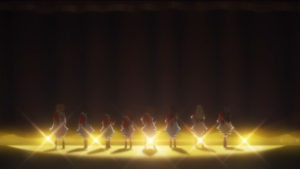 Finally, I’d like to pay special note to Revue Starlight’s opening and its multiple closings. The opening starts with this nice look at the main characters set to a slow stage curtain opening before it transitions through fun slice of life moments and on to showing the type of combat featured in the Revues. The opening song Hoshi no Dialogue (Dialogue of the Stars) is great, too. The endings are neat in that most of the episodes have similar but distinct end credits sequences based on the primary character or characters who just took part in that episode’s Revue.
Finally, I’d like to pay special note to Revue Starlight’s opening and its multiple closings. The opening starts with this nice look at the main characters set to a slow stage curtain opening before it transitions through fun slice of life moments and on to showing the type of combat featured in the Revues. The opening song Hoshi no Dialogue (Dialogue of the Stars) is great, too. The endings are neat in that most of the episodes have similar but distinct end credits sequences based on the primary character or characters who just took part in that episode’s Revue.
All In All:
Revue Starlight is an interesting anime with a unique premise. The way which it uses its magical stage play Revues to resolve various emotional and status based conflicts between its cast members is like nothing I’ve ever seen before. I love that the songs being sung by the characters in the midst of combat often mattered as much or more than the action within their fantastical stage battles. If you love anime with music and theatrics, you should at least give this a one episode try.
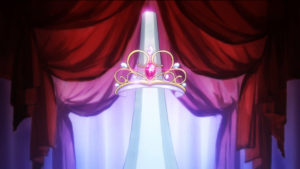 Interestingly, Revue Starlight has yet another hidden side that really pulled me in. Almost everything in the show from the varied heights of its characters to the small pink lens flare glows that are present in almost every single background serve as a veiled criticism of the real world stage shows and music schools of Japan’s Takarazuka Revue. We’ll need to Dig Deeper and enter spoiler territory to really talk about this aspect of the show, but the basics are that Revue Starlight actually speaks out quite strongly against the 100+ year old practices of pitting actresses against each other in competitions where only a handful can reach the highly revered yet highly regulated position of a Top Star.
Interestingly, Revue Starlight has yet another hidden side that really pulled me in. Almost everything in the show from the varied heights of its characters to the small pink lens flare glows that are present in almost every single background serve as a veiled criticism of the real world stage shows and music schools of Japan’s Takarazuka Revue. We’ll need to Dig Deeper and enter spoiler territory to really talk about this aspect of the show, but the basics are that Revue Starlight actually speaks out quite strongly against the 100+ year old practices of pitting actresses against each other in competitions where only a handful can reach the highly revered yet highly regulated position of a Top Star.
Because of all this, I highly encourage you to watch Revue Starlight then come back here to learn more about the sharp criticisms it is voicing, or, if you aren’t afraid of spoilers, continue along with me and learn about the show’s hidden depths so that you can go in with a better understanding of everything you are about to see.
Revue Starlight is actually one of the more interesting shows with one of the most well organized subtexts I’ve ever seen. In addition to its already tightly woven plot about the power of a long held promise, just about every aspect of the show also works to demonstrate the flaws of the real world Takarazuka Revue system. This is going to require a bit of a history lesson, so bear with me.
The Takarazuka Revue is a stage show company that was founded in 1913 by a Japanese railroad tycoon in the city of Takarazuka, Japan. The city had become a tourist city at the final stop of a rail line and in order to further boost the city’s tourist potential, this tycoon created an all girls theater that quickly grew in popularity and status. The theater eventually formed the Takarazuka Music School, an elite acting school similar to the one in the anime. This school only accepts a few of dozen young women each year. The real life school is very strict and the actresses compete against each other to become one of the handful of “Top Stars” maintained by the company at any given time.
There’s an extra wrinkle there, though. Even though the company puts on a wide variety of shows with male and female parts, think Romeo and Juliet or Phantom of the Opera, all the parts are played by female actresses. To accomplish this, the girls joining the school are split up at the end of their first year into Otokoyaku (boy role) and Musumeyaku (girl role) groups. Sadly, only Otokoyaku are eligible to become Top Stars, and typically they are paired with a single Musumeyaku whose job it is to support their performance and popularity until they retire. Tragically, retirement usually happens just a few short years after an actress obtains one of the Top Star positions since it takes so long to reach that level and since once there, the actress is at the top. There’s nowhere left to go.
In the Takarazuka system, young women compete fiercely with each other while, right off the bat, half of them have no hope of earning the most money and fame because only the ones sorted as Otokoyaku even have the potential to become a Top Star. Those are just the rules. That sorting is almost entirely based on physical attributes such as height, vocal tone, and looks. Things like acting ability and singing ability are secondary. To be a Top Star, you have to fit a certain predefined mold and everyone else is treated as significantly lesser than the Top Stars.
Just as there is only a singe Otokoyaku in each troupe, there is also only a single Musumeyaku, as well. You’d think that would make them equal, but it doesn’t. In reality, there is enormous pressure put on the Musumeyaku to support their Otokoyaku. If there’s a mistake the Otokoyaku makes, the Musumeyaku takes the responsibility. If there’s an opportunity to boost the Otokoyaku’s popularity, the Musumeyaku is obligated to pursue it. It’s the Musumeyaku’s job to enhance the desirability and fame of their Otokoyaku, but the reverse is never true.
The Top Star is the only one who truly matters in this system, but there is a ton of pressure and isolation demanded of the Otokoyaku, as well. In the past, there were strict rules like no romantic relationships for anyone at the school, especially either the Otokoyaku or Musumeyaku pairs since they have to remain potentially available to all their fans. Girls at the school or in one of the troupes, especially the Otokoyaku or their Musumeyaku, were also forbidden from receiving or responding to fan mail as well. These kinds of rules and restrictions, combined with the fierce competition to become a Top Star, led to a lot of burnouts, bullying, lawsuits, and even suicides over the years. The Takarazuka Revue has cleaned up its image a good bit in the modern age, and it has cut back on some of its rules, but all these problems still linger over it to some extent.
We can see so many aspects of the Takarazuka Revue system within Revue Starlight. For instance:
Why are Maya Tendo and Claudine Saijo generally seen as the school’s two top students? Why does the always cheerful and motherly Nana “Banana” Diaba have the ability to surpass the both of them as seen later in the series? The answer is that Maya and Banana have all the physical attributes like height and stature they need to become Otokoyaku in the Takarazuka Revue system. Claudine comes close, but ultimately she is too girly and in the real world she would have been seen as a top performing Musumeyaku. And that’s exactly where she ends up! The way Claudine breaks down in episode ten and takes responsibility for Maya’s loss are classic Musumeyaku tendencies drilled into those counterpart women who are forbidden from reaching Top Star status. Sadly, someone as hard working and skilled as Futaba Isurugi would never be considered an Otokoyaku. I believe we see her lose out to Maya, Claudine, and even her friend Kaoruko over the course of the series for largely for these reasons. (Though her loss to Kaoruko is actually its own interesting character study… Their relationship was always based on Futaba supporting and following Kaoruko. If Futaba had won, it would have driven them completely apart which neither actually wanted.)
Similarly, look at the way the Revues are set up. The girls are all battling to become the Top Star, but we later learn that the Top Star usually robs their rivals of their Shine. This is one of the real world criticisms leveled at the Takarazuka Revue system. A small handful of women, one from each acting troupe, achieve Top Star status. These women are the ones to get the fame and press and money while all the other candidates are treated as mere actors. This can be devastating to those who fail to reach the exclusive Top Star position. Revue Starlight takes this even further as we see Hikari Kagura and later Karen Ajio straight up lose the will to continue their careers after losing out to their class’ Top Star. That Karen’s ultimate loss was to her best friend just made things all the more tragic!
With all this in mind, take note of just how often our main character Karen Ajio goes against the Takarazuka Revue system. Her promise to Hikari is for them to share the spotlight… in direct contrast to the Top Star system that recognizes one actress above all others. Her declaration at the end of her transformation sequence, “We will all do Starlight!”, sets it up for all her classmates to join her as equals on the stage which, again, is the opposite of the normal Top Star system.
In contrast, look at Maya and Claudine. Both of them never really had any competition until they met each other. And how do they eventually end up? As an Otokoyaku and Musumeyaku pair determined to claim their first and second place roles from within the Takarazuka Revue system! It’s not an accident that these two represent one of the final obstacle our main characters have to overcome.
It’s all this history and deliberate veiled criticism that I think propels Revue Starlight past its merely average presentation to become one of the more interesting anime I’ve had the pleasure to dig deeper into. But that’s not all there is to say. I didn’t know any of this when I started Revue Starlight, and I almost abandoned it because of that. But then, I caught a series of videos and articles that go into even more detail and saved the show for me:
- Under The Scope’s Building A Stage Girl: Behind The Scenes with Revue Starlight Staff and Staging The Story: The Visual Theater of Revue Starlight
- Emily Rand’s Atelier Emily blog has multiple articles discussing the symbolism of Revue Starlight.
- Andrea Ritsu’s Between The Revues series focusing on the origins and problems with Takarazuka Revue
Review: A Place Further Than The Universe
In Short:
A Place Further Than The Universe is a 2018 anime by Madhouse that follows the challenges and triumphs of four Japanese high school girls who become the best of friends after choosing to join a research expedition to Antartica. The show features strong art and animation, great characterizations for its four leads, a realistic portrayal of just what it takes to go on such a journey, a ton of great humor and funny moments, and a surprising amount of depth and heartache that you might not expect given the show’s premise and early episodes.
Suggested Minimum Watch: 1 episode. If you don’t love the show by the end of the end credits train ride you’d be better off finding something else.
Full Review:
 When I first saw the key art and heard the initial pitch for A Place Further Than The Universe, I almost immediately put it in my ignore pile. The premise of four high school girls going on an adventure to Antartica just seemed too cutesy to me. The visuals reminded me a bit too much of shows like Girls und Panzer and High School Fleet, two shows where groups of girls join their school’s tank club or crewed warships with no adults and no real risks or dangers. I figured A Place Further Than The Universe was like that. Cutesy without any real substance. Turns out I was super wrong! Instead, this is a show that is both packed with humor and laughs, and one that tells a surprisingly character focused coming of age story.
When I first saw the key art and heard the initial pitch for A Place Further Than The Universe, I almost immediately put it in my ignore pile. The premise of four high school girls going on an adventure to Antartica just seemed too cutesy to me. The visuals reminded me a bit too much of shows like Girls und Panzer and High School Fleet, two shows where groups of girls join their school’s tank club or crewed warships with no adults and no real risks or dangers. I figured A Place Further Than The Universe was like that. Cutesy without any real substance. Turns out I was super wrong! Instead, this is a show that is both packed with humor and laughs, and one that tells a surprisingly character focused coming of age story.
The show begins with Mari Tamaki, a second year Japanese high school student who wakes up one morning and realizes that she hasn’t really done anything with her life. Desperate to go on an adventure, she attempts to skip class one morning but chickens out and ends up at school on time, same as always. That evening, on her way home, she happens to pick up a bank envelope dropped by an unknown girl from school who rushes by. Inside is a million yen! Mari manages to track down the owner the next day and is introduced to Shirase Kobuchizawa, a girl her age who is determined to make her way to Antartica.
After a bit of a rough start, the two girls hit it off and soon come in contact with Hinata Miyake, an intelligent, upbeat girl their age who works full time while studying for college, and Yuzuki Shiraishi, a girl from out of town who is a year younger than them and who is a childhood actress and social media star. She is being forced to accompany an expedition to Antartica to record a social media type documentary.
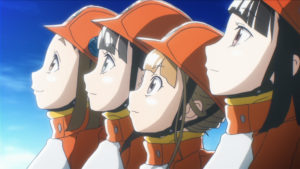 These four girls are the main reason to watch A Place Further Than The Universe. Each has a distinct personality, and a distinct reason for wanting to go to Antartica.
These four girls are the main reason to watch A Place Further Than The Universe. Each has a distinct personality, and a distinct reason for wanting to go to Antartica.
- Mari is goofy and upbeat, but, having done very little beyond obtain perfect attendance and excellent grades at school, she is a little sheltered as to how the real world works. She wants to go on the trip so she can say she actually did something.
- Hinata is fun loving, athletic, and smart enough to become the brains of the group, but she tends to hide her troubles behind a laugh and a smile. She says she just wants to do something big before entering university, but her stated reasons for dropping out of school aren’t the whole story.
- Yuzuki is essentially the girls’ ticket to Antartica. Her mother is helping fund the expedition and Yuzuki is set to record a fun, social media heavy show detailing her trip. Sadly, because she’s been a child actress for as long as she can remember, Yuzuki has never had much time for friends. Worse, often any friends she does try to make care more about her popularity than actually getting to know her.
- Then there’s Shirase. At the start of the story she has a somewhat cynical, reserved personality and her plans are often a little under-thought, but she is determined to get to Antartica as part of the upcoming public expedition absolutely no matter what. You see, her mother was a member of the previous research expedition that left for Antartica more than three years ago. But, while the rest of the team returned home, Sirase’s mother did not. She was lost in a blizzard, never to be seen again.
 A Place Further Than The Universe is a show filled with jokes and laughs and humorous situations, mostly of the four girls’ making, but it is also a show that has a more serious undercurrent. Though it’s not obvious at first, each of the four girls has some obstacle in their life that they wish they could overcome, and the friendships they form with each other during their joint trip to Antartica helps them do just that.
A Place Further Than The Universe is a show filled with jokes and laughs and humorous situations, mostly of the four girls’ making, but it is also a show that has a more serious undercurrent. Though it’s not obvious at first, each of the four girls has some obstacle in their life that they wish they could overcome, and the friendships they form with each other during their joint trip to Antartica helps them do just that.
The resolution to Shirase’s troubles had me in full on tears like no anime has before or since. The full stories of the other three girls turned out to be pretty impactful, as well, and serve to further illustrate the strong bonds of friendship they form along the way. The friendships these four girls make on their journey, combined with the emotional payoffs to their individual stories, puts this anime on a different level than many of its peers.
Beyond its four main characters, A Place Further Than The Universe boasts a surprisingly solid look at what it takes to attempt an expedition to Antartica. There’s an episode dedicated to training for the trip. There’s an episode just about exploring the ship that will be their home for the weeks long journey. There’s an episode all about life on board the icebreaker as it sails from Australia to Antartica. Although issues like loading supplies, or obtaining funding, or the sacrifices people make to go on such an expedition are never super heavily focused on, they all come up during the course of the series. Really, what I thought would be the four girls’ unrealistically goofy adventure actually turned out to kinda be the opposite. There is realism to spare here, and the show is all the better for it.
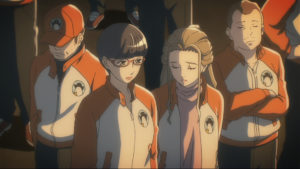 In a show about high school girls going on an adventure, a decent amount of attention is given to the secondary adult characters, as well. In particular, Mission commander Gin Todo and vice commander Kanae Maekawa, both of whom were close friends of Shirase’s mother, have standout minor roles. Gin’s relationship, or lack thereof, with Shirase is one of the high points of the series. The loss of Shirase’s mother, who was friends with most of the returning crew, is keenly felt throughout the second half of the show. Not in any big way, but there’s a subtle acknowledgment of sadness and a determination to try again despite the last trip ending in tragedy that makes things feel ever more real.
In a show about high school girls going on an adventure, a decent amount of attention is given to the secondary adult characters, as well. In particular, Mission commander Gin Todo and vice commander Kanae Maekawa, both of whom were close friends of Shirase’s mother, have standout minor roles. Gin’s relationship, or lack thereof, with Shirase is one of the high points of the series. The loss of Shirase’s mother, who was friends with most of the returning crew, is keenly felt throughout the second half of the show. Not in any big way, but there’s a subtle acknowledgment of sadness and a determination to try again despite the last trip ending in tragedy that makes things feel ever more real.
That’s not to say this show isn’t also goofy and enjoyable, because it certainly is. The girls’ antics had me cracking up more often than not while watching this series. They joke and goad and screw up and make amends and grow as people in the funniest ways that feel authentic to four high school girls tagging along to Antartica. The show does a great job balancing the handful of truly sad moments with the general sense of cheerfulness and adventure that it puts forth most of the time.
 A Place Further Than The Universe is also a beautifully animated series. When it wants to, it’s artistry can rival even anime like Your Name or Violet Evergarden. In particular, it pulls some of the same tricks we see in Makoto Shinkai films where it recreates the look and feel of real world locations with a great attention to detail. The real life Antarctic base of Syowa Station really comes alive in animated form, as do the tourists areas of Singapore and the port areas of Australia’s Fremantle. The show also often goes above and beyond on its animation. A goofy chase scene in the second episode is fantastically well done, but just everywhere you look there are extra touches and flourishes to both the foreground and background characters that help enliven each and every scene.
A Place Further Than The Universe is also a beautifully animated series. When it wants to, it’s artistry can rival even anime like Your Name or Violet Evergarden. In particular, it pulls some of the same tricks we see in Makoto Shinkai films where it recreates the look and feel of real world locations with a great attention to detail. The real life Antarctic base of Syowa Station really comes alive in animated form, as do the tourists areas of Singapore and the port areas of Australia’s Fremantle. The show also often goes above and beyond on its animation. A goofy chase scene in the second episode is fantastically well done, but just everywhere you look there are extra touches and flourishes to both the foreground and background characters that help enliven each and every scene.
The show is no slouch musically, either. The main theme is upbeat and enjoyable, but it’s the reoccurring insert song Haru ka Tooku (roughly, “No Matter How Far”), that gets played during moments of friendship and forward movement that really gets me. The music knows just when to come in to perfectly enhance moments of adventure or sadness.
All In All:
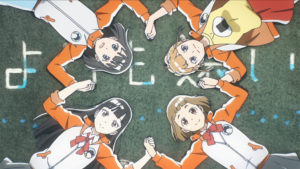 A Place Further Than The Universe is something I did not expect. It is hilarious, charming, heartwarming, and occasionally tear jerking. And it’s all based on the strength of its characters and the journey they go on together. Plus, and this is a minor point, it wasn’t made to sell an incomplete manga or light novel. It was made solely to be a great anime, something that is fairly unique these days.
A Place Further Than The Universe is something I did not expect. It is hilarious, charming, heartwarming, and occasionally tear jerking. And it’s all based on the strength of its characters and the journey they go on together. Plus, and this is a minor point, it wasn’t made to sell an incomplete manga or light novel. It was made solely to be a great anime, something that is fairly unique these days.
Review: Planetes Anime
In Short:
Planetes is a well made, character-driven anime that depicts life and work in Earth’s orbit in the near future of 2075. Its realistic portrayal of space, combined with its complex, well-rounded ensemble cast, delivers humor and fun along with a strong helping of angst and character drama.
Even though its art direction is top notch, Planetes is an older series, and that sometimes shows up in art you’ll wish matched up better with today’s higher resolutions.
Suggested Minimum Watch: 1 episode. You get to meet most everyone and you get to hear the first of Tanabe’s several epic rants about love.
Full Review:
It was something of a Space Week last week for me and millions of others across the globe as SpaceX launched two Astronauts on a test flight of their new Dragon crew capsule. I celebrated in a bunch of different ways: I finally got around to building my LEGO International Space Station. I listened to podcast about the Apollo program. I watched my copy of Apollo 13 (the director commentary this time.) But even after the docking I still wanted to do something else, so I’ve loaded up my copy of the 2003 anime Planetes and have been having a blast rewatching it.
There are several great anime set in space. Obviously, I have the entire Macross Frontier Episode Guide here at my site, but I also love anime like Cowboy Bebop, Space Battleship Yamato 2199, Aldnoah.Zero, and Strain: Strategic Armored Infantry. One thing all these anime have in common, however, is though they may be set in space, they are generally not about space. There is one anime, though, that is different. One that explores what the near future of life in orbit might be like. And it is great!
 Released in 2003, Planetes primarily follows the lives of six members of a fictional space-based corporation called Technora in the year 2075. Based out of a large space station in earth orbit, Technora is made up of a number of different divisional Sections each with their own jobs and responsibilities. Our main cast doesn’t work in the Control Section which acts as the space station’s air traffic control, nor do they work in Administrative section or Engineering Section or Accounting Section… no, they work for Technora’s much derided Debris Section. Their job is to go out in an old beat up cargo shuttle and retrieve or deorbit space debris before it can collide with other ships, satellites, or stations. They are essentially Space Trash Collectors, and while their jobs are important to help keep earth’s orbit free of dangerous space junk, they aren’t paid particularly well and don’t contribute much to Technora’s bottom line.
Released in 2003, Planetes primarily follows the lives of six members of a fictional space-based corporation called Technora in the year 2075. Based out of a large space station in earth orbit, Technora is made up of a number of different divisional Sections each with their own jobs and responsibilities. Our main cast doesn’t work in the Control Section which acts as the space station’s air traffic control, nor do they work in Administrative section or Engineering Section or Accounting Section… no, they work for Technora’s much derided Debris Section. Their job is to go out in an old beat up cargo shuttle and retrieve or deorbit space debris before it can collide with other ships, satellites, or stations. They are essentially Space Trash Collectors, and while their jobs are important to help keep earth’s orbit free of dangerous space junk, they aren’t paid particularly well and don’t contribute much to Technora’s bottom line.
There are a two main things that make Planetes something of a must watch anime:
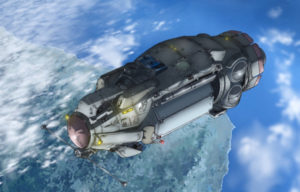 1. It is set in a near future of commercial space operations that you can almost see from the here and now if you squint hard enough. Planetes gets almost everything about space right. Spacesuits are big and bulky. Moving around in zero gravity is tough to get a hang of. Ships don’t zip about or change directions easily even when their engines are at full power. And, of course, engines, thrusters, and, heck, even laser defense satellites make zero noise out in the vacuum of space.
1. It is set in a near future of commercial space operations that you can almost see from the here and now if you squint hard enough. Planetes gets almost everything about space right. Spacesuits are big and bulky. Moving around in zero gravity is tough to get a hang of. Ships don’t zip about or change directions easily even when their engines are at full power. And, of course, engines, thrusters, and, heck, even laser defense satellites make zero noise out in the vacuum of space.
We get to see everything from moon colonies, to astronaut training, to a spaceship capable of transversing the solar system, but it’s all done in ways that makes a whole lot of sense given where actual space technology seems to be going. Planetes’ realistic vision of life in space is easily one of the best out there in any medium.
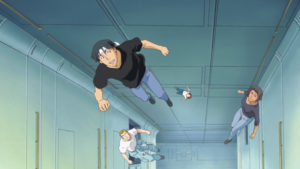 2. Its complex, well rounded characters and their relationships drive the show. Yes, there are some interesting plots and happenings that put our Debris Section employees into challenging situations, but more so it’s the hopes, fears, and desires of our main cast that push them into places they never thought they would, or could, end up. Sometimes, their journeys are a struggle. Not everyone is ascendent. Not everyone achieves their goals. And the ones that do sometimes take routes that both they, and their colleagues, wish they hadn’t.
2. Its complex, well rounded characters and their relationships drive the show. Yes, there are some interesting plots and happenings that put our Debris Section employees into challenging situations, but more so it’s the hopes, fears, and desires of our main cast that push them into places they never thought they would, or could, end up. Sometimes, their journeys are a struggle. Not everyone is ascendent. Not everyone achieves their goals. And the ones that do sometimes take routes that both they, and their colleagues, wish they hadn’t.
That’s not to say Planetes is depressing or all about drama, drama, and more drama. It, and its characters, have good times as well as bad. The members of Debris Section, in particular, are mostly oddballs that are somewhat looked down upon. They don’t have a lot of staff. They have barely any corporate influence at all. But, on the plus side, it means that they aren’t all that closely supervised and can get away with a good bit of goofing off and trouble making that the more respectable sections, like Control Section, could only dream of.
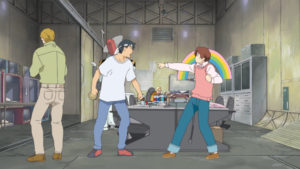 On top of that, some of the main cast can get pretty eccentric at times. Take Ai Tanabe, the newest, most inexperienced member of Debris Section who will, at the drop of a hat, yell your head off about how life is not worth living without love even as everyone around her scoffs or mocks her for it. Or, take Fee Carmichael, Debris Section’s primary ship pilot whose addiction to smoking, despite living in space where it is almost universally forbidden, leads to one of the most exciting moments in the series. Then there’s Debris Section’s second in command, Arvind “Robbie” Lavie, who is such a bend over backwards yes man completely devoted to pleasing the highest ranking person in the room that his antics drive a decent portion of the show’s comedy.
On top of that, some of the main cast can get pretty eccentric at times. Take Ai Tanabe, the newest, most inexperienced member of Debris Section who will, at the drop of a hat, yell your head off about how life is not worth living without love even as everyone around her scoffs or mocks her for it. Or, take Fee Carmichael, Debris Section’s primary ship pilot whose addiction to smoking, despite living in space where it is almost universally forbidden, leads to one of the most exciting moments in the series. Then there’s Debris Section’s second in command, Arvind “Robbie” Lavie, who is such a bend over backwards yes man completely devoted to pleasing the highest ranking person in the room that his antics drive a decent portion of the show’s comedy.
Every member of the Debris Section, and quite a few of the lesser cast of characters, all have senses of humor, and personal sticking points, and reasons for why they behave the way they do. There are friendships made and broken. Arguments that persist a long time only to finally be resolved. And choices that make total sense but will, at the same time, have you wanting to grab hold of characters and shake them, and make them realize just what they are doing to themselves and others.
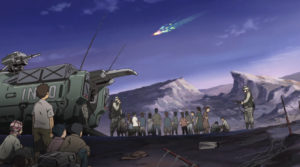 Another reason I like it is Planetes speaks to bigger things. With so many realistically portrayed characters, it kinda has to. As the show progresses, it touches on things like: national economic disparity, racism, abusive relationships, corporate greed, dying with dignity, harsh uncompromising determination, and more. But, again, Planetes isn’t a depressing show by any means. There are plenty of friendships and growing moments and characters finding the strength to overcome their troubles or hold fast to their ideals, too.
Another reason I like it is Planetes speaks to bigger things. With so many realistically portrayed characters, it kinda has to. As the show progresses, it touches on things like: national economic disparity, racism, abusive relationships, corporate greed, dying with dignity, harsh uncompromising determination, and more. But, again, Planetes isn’t a depressing show by any means. There are plenty of friendships and growing moments and characters finding the strength to overcome their troubles or hold fast to their ideals, too.
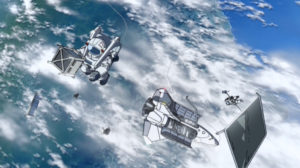 Animation wise, Planetes is decent, but there’s always a sense that it sure would have been great if it had been made in 2013 instead of 2003. Don’t get me wrong, ships and stations and characters and background are all pretty well detailed and animated, but the show does maybe lack the sort of awe inspiring grandeur that a realistic show set in 2075 made more recently might otherwise have. In particular, I wish some of the shots of earth were crips, detailed, 4k backdrops instead of nice but somewhat blurry 2003 artwork. That said, everything space related is so well realized, plus this is one of the fairly rare shows that actually take the time to make good graphics for the things that appear on screens and reports, so that, at least, makes me happy.
Animation wise, Planetes is decent, but there’s always a sense that it sure would have been great if it had been made in 2013 instead of 2003. Don’t get me wrong, ships and stations and characters and background are all pretty well detailed and animated, but the show does maybe lack the sort of awe inspiring grandeur that a realistic show set in 2075 made more recently might otherwise have. In particular, I wish some of the shots of earth were crips, detailed, 4k backdrops instead of nice but somewhat blurry 2003 artwork. That said, everything space related is so well realized, plus this is one of the fairly rare shows that actually take the time to make good graphics for the things that appear on screens and reports, so that, at least, makes me happy.
All in All:
Planetes is a wonderful show for anyone who loves space. It gets so much right in so many areas that the few places it is lacking are almost just complete non-issues.
Macross Frontier Episode Guide 27: Wings of Farewell
 Like the first movie, we start this movie with a voiceover while looking at a purple star field. This time though, we quickly move to a new Sheryl Nome production of the song “Forbidden Elixir.” Last time, Sheryl played the parts of white and black bunnies in her big opening number. This time, she plays both wife and husband! At the end of all the amazing, over the top special effects, Sheryl collapses on stage… and it isn’t part of the show.
Like the first movie, we start this movie with a voiceover while looking at a purple star field. This time though, we quickly move to a new Sheryl Nome production of the song “Forbidden Elixir.” Last time, Sheryl played the parts of white and black bunnies in her big opening number. This time, she plays both wife and husband! At the end of all the amazing, over the top special effects, Sheryl collapses on stage… and it isn’t part of the show.
The recap that follows the concert does a pretty good job of summing up the first movie and brings us to the aftermath of Sheryl’s collapse. She is playing it off as nothing big and even goes so far to tell Ranka that she is fine. It is amusing to see Alto roped into playing the role of her escort. I like here how Alto and Ranka get along and are able to share little secrets like the friends (best friends?) that they’ve been set up to be by the first movie. It’s also amusing that Sheryl is still at least partially funding the SMS!
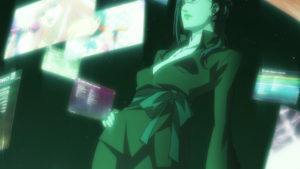 The next scene with Grace in her virtual space talking to her co-conspirators makes it pretty clear that the Galaxy’s plot to rule the universe is very much alive and well. This time, they are even talking about some sort of operation or transplant to combine Sheryl and Ranka’s powers, but some of the intelligences are unsure about it because the procedure might kill both Sheryl and Ranka. That’s a pretty big change from the series where Grace basically only wanted Ranka and all but left Sheryl to die cold and alone. The end goal still seems to be to using singing and perhaps fold quartz to analyze the Vajra’s control protocol, however. This time, we get a clearer indication that Leon is aware of the Galaxy’s plot as he is listening in on their conversation.
The next scene with Grace in her virtual space talking to her co-conspirators makes it pretty clear that the Galaxy’s plot to rule the universe is very much alive and well. This time, they are even talking about some sort of operation or transplant to combine Sheryl and Ranka’s powers, but some of the intelligences are unsure about it because the procedure might kill both Sheryl and Ranka. That’s a pretty big change from the series where Grace basically only wanted Ranka and all but left Sheryl to die cold and alone. The end goal still seems to be to using singing and perhaps fold quartz to analyze the Vajra’s control protocol, however. This time, we get a clearer indication that Leon is aware of the Galaxy’s plot as he is listening in on their conversation.
 Next up we have… huh… a beach episode! Seems about time. Macross 7 had a tropical ship of a different shape but similar interior to this one in the Frontier fleet. Macross Zero was one long beach episode, sorta, I guess. (It was set on a tropical island, at least.) Macross Plus never went down to a beach but there was a scenic overlook. Macross Delta is largely set on a tropical planet and there are scenes of beaches. Probably SDF: Macross and Do You Remember Love? are the only shows in Macross’ long history to not have anything resembling a beach episode. That said, despite the volleyball, and surfing, and scuba diving, and sun reflecting off the ocean, this part of the movie actually has a good bit of foreshadowing and importance. The question of whether the Vajra can feel is a part of that, but there’s also smaller hints at some fun thing to come.
Next up we have… huh… a beach episode! Seems about time. Macross 7 had a tropical ship of a different shape but similar interior to this one in the Frontier fleet. Macross Zero was one long beach episode, sorta, I guess. (It was set on a tropical island, at least.) Macross Plus never went down to a beach but there was a scenic overlook. Macross Delta is largely set on a tropical planet and there are scenes of beaches. Probably SDF: Macross and Do You Remember Love? are the only shows in Macross’ long history to not have anything resembling a beach episode. That said, despite the volleyball, and surfing, and scuba diving, and sun reflecting off the ocean, this part of the movie actually has a good bit of foreshadowing and importance. The question of whether the Vajra can feel is a part of that, but there’s also smaller hints at some fun thing to come.
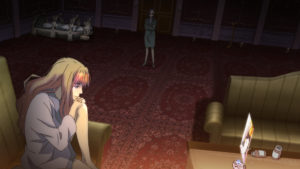 In the next scene, partially overlapping with the beach episode scenes, we see that Sheryl really is sick. She is dying perhaps even more obviously than in the series where she mainly just fainted. It seems one option for Sheryl is to become a full body cyborg like Grace. But this would apparently put an end to her singing career, though we’re not told exactly how. Here, for the first time, Grace brings up the “kill Ranka and transplant her organs” option. The translation I have talks about transplanting Ranka’s blood, but every other mention fully implies that Ranka will not be alive at the end of the procedure. Even what Grace says in the car trip to Ranka’s concert had that implication.
In the next scene, partially overlapping with the beach episode scenes, we see that Sheryl really is sick. She is dying perhaps even more obviously than in the series where she mainly just fainted. It seems one option for Sheryl is to become a full body cyborg like Grace. But this would apparently put an end to her singing career, though we’re not told exactly how. Here, for the first time, Grace brings up the “kill Ranka and transplant her organs” option. The translation I have talks about transplanting Ranka’s blood, but every other mention fully implies that Ranka will not be alive at the end of the procedure. Even what Grace says in the car trip to Ranka’s concert had that implication.
Ranka’s opening number, “Rainbow Colored Bear” is amazingly well done, but Sheryl looks so sad during most of it. Is it because she knows that the plan is to kill Ranka soon afterwards?
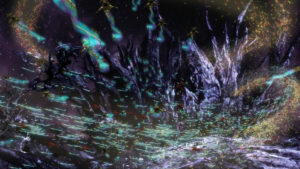 Out ahead of the Frontier fleet, SMS is conducting an operation to clear out a Vajra nest. Ranka’s thoughts about the Vajra having emotions return to Alto as he is trying to find a way to kill the queen controlling the local swarm. Alto is badly injured when the queen stabs through the center of his Valkyrie, but before he ejects he notices that the Vajra are helping their wounded out of harms way. Note that in this version, Alto does manage to grab Sheryl’s earring before ejecting.
Out ahead of the Frontier fleet, SMS is conducting an operation to clear out a Vajra nest. Ranka’s thoughts about the Vajra having emotions return to Alto as he is trying to find a way to kill the queen controlling the local swarm. Alto is badly injured when the queen stabs through the center of his Valkyrie, but before he ejects he notices that the Vajra are helping their wounded out of harms way. Note that in this version, Alto does manage to grab Sheryl’s earring before ejecting.
Later, Sheryl races to Alto’s bedside on the news that he was wounded only to find him well on the road to recovery. As Sheryl and Alto are having moment, both indoors and later outdoors, Grace is carrying out her plot to take over Frontier. Apparently the refugees that SMS rescued, the one that Sheryl personally paid at least 150 million credits to save, were in actuality cyborgs from the Galaxy fleet whose job it is to infiltrate and kill their way into control of the Frontier fleet!
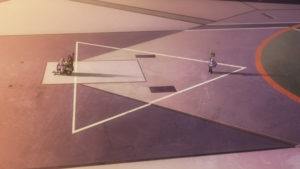 The moment with Sheryl and Alto is interesting, because while Sheryl knew about Alto’s past like in the series, this time around she pleads with him to go back to acting and stop risking his life as a pilot. Unfortunately, Ranka finds the two of them together, though the moment doesn’t seem quite as dramatic or spirit breaking for Ranka as it was in the series.
The moment with Sheryl and Alto is interesting, because while Sheryl knew about Alto’s past like in the series, this time around she pleads with him to go back to acting and stop risking his life as a pilot. Unfortunately, Ranka finds the two of them together, though the moment doesn’t seem quite as dramatic or spirit breaking for Ranka as it was in the series.
What happens next, though, is very different. Grace’s plans that had been going so smoothly are suddenly and violently ended as Frontier’s covert forces under Leon’s command kill most of the Galaxy infiltrators. They even open fire on Grace herself as she tries to surrender! Leon shows up personally to apprehend Sheryl, and calls her out specifically for using her fold quartz earrings to lure the Vajra to Frontier! And, by the way Sheryl turns her head in shame when Alto declares that it isn’t true, Leon may even be right about that! Sheryl is immediately booked into prison and, according to wartime law, she is to be executed without even a trial.
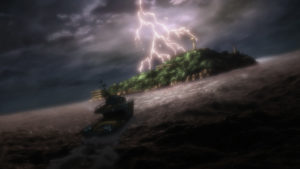 Alto takes Sheryl’s acts as something of a betrayal. He nearly throws away her earring, but for some reason can’t do it. Ranka, however, heads to the island prison, the one we’ve seen in the distance in several shots even in the first movie, to learn more about Sheryl’s true feelings. In the end, Sheryl admits that she loves Alto at least as much as Ranka does.
Alto takes Sheryl’s acts as something of a betrayal. He nearly throws away her earring, but for some reason can’t do it. Ranka, however, heads to the island prison, the one we’ve seen in the distance in several shots even in the first movie, to learn more about Sheryl’s true feelings. In the end, Sheryl admits that she loves Alto at least as much as Ranka does.
Later, when Luca complains about Sheryl’s treatment, Leon threatens him and his sister, a sister that never existed in the TV series that we know of, and later has one of his men cut Luca’s lifeline during a spacewalk and shove him to his doom. Fortunately, Luca’s actions were backed by the SMS and he is quickly rescued. We also get a brief moment between Ranka and Brera where Brera reveals Leon’s plot to take over the Vajra. And that he is Ranka’s brother. That fact felt a bit shoved in this time around. There’s also a great scene between Alto and Ozma where Ozma explains how everyone, not just Alto, is always playing roles.
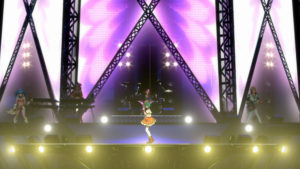 With all these little pieces coming together, SMS goes rogue similar to how it did in the series, and they start by enacting a crazy plan to rescue Sheryl. A plan that involves several SMS members dressing up as a knockoff band called the Lovely Bombers that looks an awful lot like the band Fire Bomber from the Macross 7 anime series. While Ranka and the Lovely Bombers distract the guards and inmates, Luca hacks the prison’s security systems and Alto, dressed up as a girl, goes to break Sheryl out of her jail cell.
With all these little pieces coming together, SMS goes rogue similar to how it did in the series, and they start by enacting a crazy plan to rescue Sheryl. A plan that involves several SMS members dressing up as a knockoff band called the Lovely Bombers that looks an awful lot like the band Fire Bomber from the Macross 7 anime series. While Ranka and the Lovely Bombers distract the guards and inmates, Luca hacks the prison’s security systems and Alto, dressed up as a girl, goes to break Sheryl out of her jail cell.
Ranka, Alto, and Sheryl make their escape from the prison but are met by Brera who intends to continue with Galaxy’s plan to kill Ranka to empower Sheryl. A tense running battle ensues between Brera and Ozma, the latter who shows up at the last second to save the day. Then, when things look to be at their worst, a hit from the battle with the Vajra outside tears open a hole in the hull and threatens to suck most of the main characters out into space. In a great moment, Sheryl purposely sacrifices herself to push Ranka to safety!
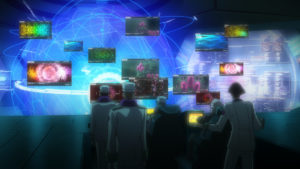 Meanwhile, President Glass’ decision to go with Leon’s plan to take control of the Vajra appears to be successful. This time, instead of battling impossible odds, Leon’s forces reach the Vajra homeworld while in control of an increasingly sizable force of Vajra as brainwashed escorts. Or, the plan would have been successful for Leon’s forces if Brera had not single-handedly taken out everyone on Battle Frontier’s bridge. It seems that that masterminds behind the Galaxy’s infiltration of Frontier were just a bit more prepared than we were led to believe.
Meanwhile, President Glass’ decision to go with Leon’s plan to take control of the Vajra appears to be successful. This time, instead of battling impossible odds, Leon’s forces reach the Vajra homeworld while in control of an increasingly sizable force of Vajra as brainwashed escorts. Or, the plan would have been successful for Leon’s forces if Brera had not single-handedly taken out everyone on Battle Frontier’s bridge. It seems that that masterminds behind the Galaxy’s infiltration of Frontier were just a bit more prepared than we were led to believe.
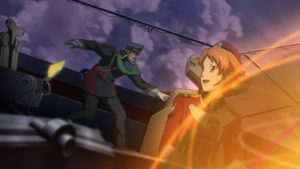 Alto, Ranka, and the other SMS survivors follow Island 1 and Battle Frontier to the Vajra homeward onboard the Macross Quarter. Ranka finally confesses her love to Alto. In this movie timeline, she plays Sheryl’s role from the series where she asks Alto not to respond because she is unsure she’d be able to sing if she knew his answer either way. Afterwards, Alto engages the Vajra in a terrific high speed, mostly bloodless dogfight set to Ranka’s new song “Houkago Overflow” (After School Overflow). The animation here is great, especially as Macross Quarter itself dives down into the atmosphere using a large chunk of Island 1’s damaged shell as first a heat shield and then a sky surf board! Remember Captain Wilder surfing during the beach episode segment? Alto finally realizes that the Vajra are being controlled through the implant missiles that Frontier’s forces hit them with, but his fighter takes a hard hit moments before he can tell the others.
Alto, Ranka, and the other SMS survivors follow Island 1 and Battle Frontier to the Vajra homeward onboard the Macross Quarter. Ranka finally confesses her love to Alto. In this movie timeline, she plays Sheryl’s role from the series where she asks Alto not to respond because she is unsure she’d be able to sing if she knew his answer either way. Afterwards, Alto engages the Vajra in a terrific high speed, mostly bloodless dogfight set to Ranka’s new song “Houkago Overflow” (After School Overflow). The animation here is great, especially as Macross Quarter itself dives down into the atmosphere using a large chunk of Island 1’s damaged shell as first a heat shield and then a sky surf board! Remember Captain Wilder surfing during the beach episode segment? Alto finally realizes that the Vajra are being controlled through the implant missiles that Frontier’s forces hit them with, but his fighter takes a hard hit moments before he can tell the others.
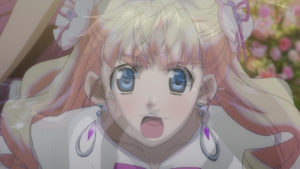 Alto fades to black and in his place we see a memory that we first think is from Alto’s point of view but soon we learn that it is actually from Sheryl’s. Both she and Ozma survived their spacing thanks to a quick intervention by Ai-kun. What’s more, Grace somehow escaped too and comes to Sheryl’s rescue as best she can. Most notably, she retrieved the fold quartz earring that Leon had under research directly off to the side of her containment tank. With her earring back, Sheryl begins to sing and her song is able to revive Alto who mounts a rescue. For the first time, Alto recognizes that Sheryl is that same little girl as the one who was at one of his kabuki plays and who promised that she would someday shake the galaxy.
Alto fades to black and in his place we see a memory that we first think is from Alto’s point of view but soon we learn that it is actually from Sheryl’s. Both she and Ozma survived their spacing thanks to a quick intervention by Ai-kun. What’s more, Grace somehow escaped too and comes to Sheryl’s rescue as best she can. Most notably, she retrieved the fold quartz earring that Leon had under research directly off to the side of her containment tank. With her earring back, Sheryl begins to sing and her song is able to revive Alto who mounts a rescue. For the first time, Alto recognizes that Sheryl is that same little girl as the one who was at one of his kabuki plays and who promised that she would someday shake the galaxy.
Alto is finally able to relay his report about the Vajra implants and SMS is able to start cutting or shooting the key bits off the mind-controlled Vajra, freeing them from Galaxy’s control. Thus begins a fantastic repeat of the Nyan Nyan service melody from the series (now called Nyan Nyan Final Attack) where many of the same things happen like where the freed Vajra gather to protect Island 1 and Macross Quarter from a blast fired by the enemy Vajra/Galaxy hybrid. Macross Quarter looks to be dead in the Vajra’s sights, but fortunately, SMS and NUNS received their distress call in time and sent a fleet to help stop the enslavement of the Vajra.
 Sheryl and Ranka are reunited and begin the final battle song of the movie. Alto and Brera have a spectacular dogfight as Alto helps spread Sheryl and Ranka’s song to the Vajra and their captive queen. Between Ranka, Alto, and Sheryl, they are able to free Brera from his own implant. Afterwards, Brera makes the ultimate sacrifice to kill the grotesque bodies of the Galaxy plot’s masterminds. The Vajra queen catches Alto as friendly forces fire multiple Macross cannons in its direction. It should be the end of Alto and the queen, but the queen uses its immense fold distortion powers to allow Alto a final few seconds to say goodbye to Ranka and let him almost express his love for Sheryl before it folds him and itself safely out of harm’s way. The rest of the Vajra soon follow, leaving the planet to humanity.
Sheryl and Ranka are reunited and begin the final battle song of the movie. Alto and Brera have a spectacular dogfight as Alto helps spread Sheryl and Ranka’s song to the Vajra and their captive queen. Between Ranka, Alto, and Sheryl, they are able to free Brera from his own implant. Afterwards, Brera makes the ultimate sacrifice to kill the grotesque bodies of the Galaxy plot’s masterminds. The Vajra queen catches Alto as friendly forces fire multiple Macross cannons in its direction. It should be the end of Alto and the queen, but the queen uses its immense fold distortion powers to allow Alto a final few seconds to say goodbye to Ranka and let him almost express his love for Sheryl before it folds him and itself safely out of harm’s way. The rest of the Vajra soon follow, leaving the planet to humanity.
Unfortunately, as the battle ends, Sheryl’s body finally succumbs to her V-Type infection and she collapses. In an aftermath recap, Ranka narrates the situation a month after the final battle. Alto is still missing. Sheryl looks to have had some surgery and a blood transfusion from Ranka, but is still in a coma. The survivors of the Frontier fleet are beginning their colonization of the Vajra homeworld.
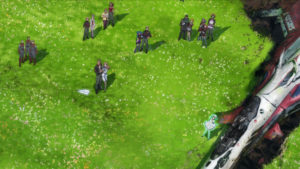 Macross Frontier ends with several scenes from both the first movie and this one played alongside the credits. It seems to be a very somber ending, except for two things:
Macross Frontier ends with several scenes from both the first movie and this one played alongside the credits. It seems to be a very somber ending, except for two things:
First, the final animated scene of the movie shows Sheryl singing in her sleep and in the final moments has her earring sparkle.
Second, Sheryl and Ranka share a fun, fast paced duet together as the credits come to an end. This song was confirmed to be set after Sheryl wakes up.
Whether this means Alto came back like Ranka was sure would happen has no solid confirmation, even as I write this closing in on ten years after the end of Macross Frontier. I like to think he did, though.
Specific Scenes I Loved:
Ranka’s singing of Aimo on the beach. The whole scene was very pretty and had some great camera angles that made it feel larger / movie sized.
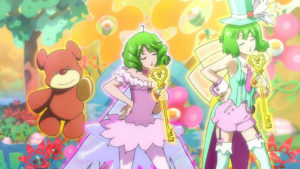 Rainbow Colored Bear, Ranka’s bright, oversaturated opening song is one of my favorite songs / visuals in all of Macross. It is more cartoonish than most of my other favorites, but the visuals are extremely well animated and the lyrics fit those visuals so perfectly! Plus, there are so many cute things going on you almost need to go back and watch it frame by frame to see the little transformation generated by Ranka’s magics. Whereas many of Sheryl’s songs are about lost love, it’s nice to have a contrast by Ranka that is all about perseverance and obtaining one’s dreams.
Rainbow Colored Bear, Ranka’s bright, oversaturated opening song is one of my favorite songs / visuals in all of Macross. It is more cartoonish than most of my other favorites, but the visuals are extremely well animated and the lyrics fit those visuals so perfectly! Plus, there are so many cute things going on you almost need to go back and watch it frame by frame to see the little transformation generated by Ranka’s magics. Whereas many of Sheryl’s songs are about lost love, it’s nice to have a contrast by Ranka that is all about perseverance and obtaining one’s dreams.
Sheryl’s explanation of what it means to her to sing. It’s interesting that Alto has at least some fond memory of his time on stage, as well. Or, at least, he understands exactly what Sheryl means because of his own experiences.
Ranka and Sheryl in prison. Sheryl’s outburst about being a normal person and not the Galactic Fairy that everyone makes her out to be was a neat touch.
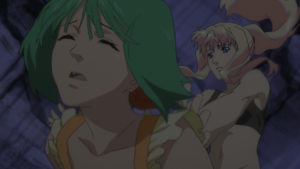 Sheryl’s ultimate sacrifice. I did not expect this at all, and I love how much emotion they conveyed between Sheryl and Alto with just a look and a tear drop.
Sheryl’s ultimate sacrifice. I did not expect this at all, and I love how much emotion they conveyed between Sheryl and Alto with just a look and a tear drop.
That *squish* that the hook makes when Grace causes it to hit that poor researcher’s face.
The scene where Alto is grieving for Sheryl and Ozma but also knows that there is nothing wrong with being sad and using that sadness to save others.
Movie Impressions
To me, this movie feels like the most correct version of Macross Frontier’s story. I never really liked the Vajra being the unstoppable, unlimitedly adaptable enemy they were in the series, so just having them as a powerful enemy that could ultimately be hijacked for nefarious purposes felt better to me.
The Galaxy fleet’s plot felt better too. In the series, we never really learned the fate of the Macross Galaxy fleet. I guess it was destroyed when Grace and company hijacked Battle Galaxy and left the civilians to die? In this version, the destruction of the Galaxy fleet is far more confirmed. But, more than that, Grace even used the SMS rescue mission to further her plans by making sure her people were among those being rescued.
Ultimately, if you combine Grace’s actions with what Leon says in this movie, it seems that both the Galaxy and Frontier fleets started to realize the power of fold quartz at the same time and made overt and covert moves against each other until one of them beat the other to the prize. It’s a pretty interesting backdrop and a pretty big change from the series where it mostly appeared that Grace went crazy when the Vajra attacked the 117th research fleet, and she got a few members of the Galaxy fleet to go along with her crazy plans.
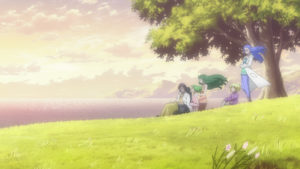 Of course, we still had that research fleet destroyed. It’s interesting how this time the research fleet’s demise was due to Mao Nome overreaching in her efforts to use songs to communicate with the Vajra. From Sheryl’s description in this movie and in the previous one, it sounded like Mao was trying to adapt the Mayan “song of the wind” to reach the Vajra. But, instead of communicating with humanity, they attacked in an effort to save Ranka from being held captive by humans. In some ways, it’s still a sad fate for Mao Nome, but I also kind of like it because it give the Macross universe this sort of feeling that maybe sometimes the heroes of one show won’t always be the heroes of the next one. Sometimes they get wiped out instead!
Of course, we still had that research fleet destroyed. It’s interesting how this time the research fleet’s demise was due to Mao Nome overreaching in her efforts to use songs to communicate with the Vajra. From Sheryl’s description in this movie and in the previous one, it sounded like Mao was trying to adapt the Mayan “song of the wind” to reach the Vajra. But, instead of communicating with humanity, they attacked in an effort to save Ranka from being held captive by humans. In some ways, it’s still a sad fate for Mao Nome, but I also kind of like it because it give the Macross universe this sort of feeling that maybe sometimes the heroes of one show won’t always be the heroes of the next one. Sometimes they get wiped out instead!
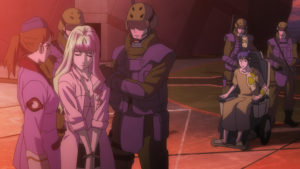 I think one of the most interesting things this movie did was make Sheryl Nome one of the bad guys. Ok… it didn’t really do that, but it kinda did. Sheryl knew about the search for Ranka even in the first movie. She knew that her home fleet was actively in competition with the Frontier fleet. In this movie, specifically, she very nearly agreed with or at least reluctantly went along with killing Ranka to preserve her own life. And, when it finally came down to it, she accepted and confirmed the accusations made against her. Accusations that included knowingly leading the Vajra to attack the Frontier fleet which must have resulted in tens of thousands if not hundreds of thousands of deaths. Sheryl was ready to die for her crimes and she even sacrificed herself to save Ranka. The only reason Sheryl was not really considered a villain by Alto and the SMS was that both Grace and the Galaxy as well as Leon and the Frontier were far worse. Both wanted to at least enslave another sentient species and were willing to spend many, many lives to reach their goals. Realistically, Sheryl is the one thing that has lived on well after the end of Macross Frontier, so there was no way they’d let her be seen as evil.
I think one of the most interesting things this movie did was make Sheryl Nome one of the bad guys. Ok… it didn’t really do that, but it kinda did. Sheryl knew about the search for Ranka even in the first movie. She knew that her home fleet was actively in competition with the Frontier fleet. In this movie, specifically, she very nearly agreed with or at least reluctantly went along with killing Ranka to preserve her own life. And, when it finally came down to it, she accepted and confirmed the accusations made against her. Accusations that included knowingly leading the Vajra to attack the Frontier fleet which must have resulted in tens of thousands if not hundreds of thousands of deaths. Sheryl was ready to die for her crimes and she even sacrificed herself to save Ranka. The only reason Sheryl was not really considered a villain by Alto and the SMS was that both Grace and the Galaxy as well as Leon and the Frontier were far worse. Both wanted to at least enslave another sentient species and were willing to spend many, many lives to reach their goals. Realistically, Sheryl is the one thing that has lived on well after the end of Macross Frontier, so there was no way they’d let her be seen as evil.
One questions I’ve always struggled with is whether these two movies are a good substitute to watching the Macross Frontier tv series. In many ways, the movies have better plots. They better define many of the characters and certainly do a better job at making the Galaxy fleet’s intentions and wrongs known to the audience. Ranka also gets a good bit better treatment in the movies than she did in the tv show. Instead of running away and abandoning a fleet of millions of people, she helped save both humanity and the Vajra from the Galaxy fleet’s evil plots! The songs are bigger. The animation is more consistent. The movies have a more definite end than the series which kinda reset to zero, especially as far as the love triangle was concerned.
On the other hand, the movies cut out a lot of the callbacks and references to past Macross works that made the Macross Frontier Series kinda special. We also got a good few less cool dogfights. No Alto vs Pixie Squadron. No Klan vs Brera. No Alto vs that Zentradi commander at Gallia 4. And, some of the scenes that were changed, like Ranka meeting Sheryl for the first time, or Ranka’s shock at seeing Alto and Sheryl together after her big performance just weren’t as impactful as they were in the series.
Ultimately, I think the movies are strong enough to stand on their own, but, I would tell anyone skipping to the movies that they will be missing some great moment, especially if they are fans of past Macross works.
Normally, I use this spot to note key things that first time viewers might not have picked up on that would come back up in the future… but there is no future. This is the end of Macross Frontier. Except for two things. If you are looking for just a little bit more Frontier, I’d suggest the following:
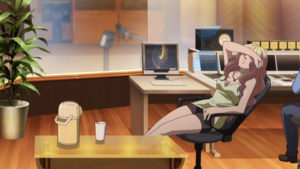 1. Track down the music clip show. It tends to be listed as something like “Macross F Music Clip Collection”. It’s about 30 minutes of new and updated animation for around seven of Frontier’s main songs. There’s also fun little Q&A segments with Sheryl and Ranka that are very short but pretty well done in terms of character and content. There’s no real plot, but if you liked Frontier’s music and its songstresses, you’ll like this.
1. Track down the music clip show. It tends to be listed as something like “Macross F Music Clip Collection”. It’s about 30 minutes of new and updated animation for around seven of Frontier’s main songs. There’s also fun little Q&A segments with Sheryl and Ranka that are very short but pretty well done in terms of character and content. There’s no real plot, but if you liked Frontier’s music and its songstresses, you’ll like this.
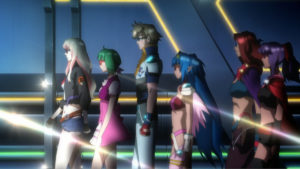 2. Go find Macross FB7. This one is a bit more out there, because FB7 is actually a strange movie-length retelling of the Macross 7 tv series, but with little Macross Frontier segments in between. Basically, Ozma finds a VHS tape of Macross 7 and he and several of the other characters from Frontier gather in his apartment to watch the older series as if they were watching long lost historical footage or something. I don’t really like Macross 7 as a show, but if you had to watch it, condensed down into movie form with frequent breaks with Frontier’s characters is about the best way to watch it. There’s also a great musical number with Sheryl and Ranka at the end where they play tributes to a series of Fire Bomber songs. That part is pretty cool and I believe it is the last substantial bit of Macross Frontier animation ever produced.
2. Go find Macross FB7. This one is a bit more out there, because FB7 is actually a strange movie-length retelling of the Macross 7 tv series, but with little Macross Frontier segments in between. Basically, Ozma finds a VHS tape of Macross 7 and he and several of the other characters from Frontier gather in his apartment to watch the older series as if they were watching long lost historical footage or something. I don’t really like Macross 7 as a show, but if you had to watch it, condensed down into movie form with frequent breaks with Frontier’s characters is about the best way to watch it. There’s also a great musical number with Sheryl and Ranka at the end where they play tributes to a series of Fire Bomber songs. That part is pretty cool and I believe it is the last substantial bit of Macross Frontier animation ever produced.
Moment to Moment Notes:
0:45 – That cross Sheryl is praying at looks remarkably like a Mayan Island bird human totem as seen in Macross Zero.
3:16 – See the MBS building in the background? That stands for Macross Broadcasting System and is a reference to the tv transmission system the civilians aboard the original Macross set up in the middle part of SDF: Macross.
3:34 – In this movie, Sheryl’s voice already has the power to generate fold waves.
4:30 – At first, I was not sure if Sheryl’s collapse was part of the production or not.
7:57 – In the upper right holoscreen is an advertisement for Ranka’s model of cellphone! Later those screens show some very old Astro Boy clips… not all of which are child friendly…
10:32 – I like how Ranka and Alto are friends in this version of the story. I think maybe it adds a little something that was missing from the original story. It gives Ranka a better reason to be hanging around with the rest of the cast, at the very least.
11:18 – Keep the word “transplant” in mind for later scenes. I believe the Galaxy group’s intentions may be slightly mistranslated later to things like “transfusion” where the idea of a full on organ transplant is what the plot and original language intend to convey.
11:41 – Again, I think this version of the story is slightly improved by the Galaxy refuge fleet having more of a point than it did in the tv show.
13:53 – Sheryl has two different voice actresses, one for normal talking and one for singing. Ranka, however, was voiced by one novice actress who was chosen for Frontier from a Japan-wide search. It is likely that she had / was personally experiencing all the hardships of being a singer and actress that she talks about in this voice over.
14:47 – Beautiful.
15:56 – I always appreciate a good scene where one character talks over and cuts off the other. The voice work / editing was done really well here.
18:09 – Sheryl’s illness gets a better arc as well in the movie.
18:53 – So, at least according to Grace, her group from the galaxy is just looking for Code Q1 (Ranka) who can fight the Vajra with her singing.
20:49 – I’m not sure how correct the translation here is. Sheryl is much to sad/conflicted about this plan for it to simply be a blood transfusion. Given everything else that is said, I think the plan is to kill Ranka and then harvest her for the blood/organs necessary to save Sheryl. Sheryl seems to say this exact thing in a later scene…
21:48 – A Boddole Zer Mobile Fortress is at the heart of any of the thousands of warlike Zentradi fleets that roam the galaxy. Humanity fought one of these in “Do You Remember Love?”. This appears to be another example of one.
24:14 – I love the use of holography to transform members of the audience!
26:26 – There’s that interceptor graphic whose like we first saw back in the “Do You Remember Love?” movie.
38:49 – The performance of Diamond Crevasse that is playing in the videos is actually a complete music video that was produced alongside a few others for a special 30+ minute musical clip show. The full version is very beautiful and touches on Sheryl’s time as an orphan on the Galaxy.
40:48 – See what they did there? With the triangle. On the ground. And in the relationship. :p
41:51 – So I guess Grace was going under a different name when interacting with the Galaxy and she really is Grace O’Connor of the 117th research fleet… Seems like maybe she should have changed her first name as well?
42:20 – Sheryl’s resigned look says that it’s true. That she really did lure the Vajra in! That’s a pretty shocking change for the character!
47:47 – So they introduced a sister for Luca and seemingly placed her somewhat in Cathy’s old role as a romantic interest of Leon’s…
50:54 – “What happened to your van again?” “Uh… some cyborg from the Galaxy fleet jumped on top of it while fleeing flying cloaked jetpack troopers…”
52:24 – It’s nice to see someone tell Alto to get over himself…
56:53 – So… that means the SMS maxed out Sheryl’s credit card?
58:23 – Note the water tower, “Ranka & Lovely Bomber”. This is a pretty direct reference to the Macross 7 band Fire Bomber and, in fact, the members of Ranka’ support team are dressed up and playing the roles of Fire Bomber members. Michael is dressed as Basara Nekki (stupid pointy hair and all!), Klan is dressed as Mylene Jenius and matches that character’s stature and clothing pretty closely. SMS’s medic Canaria Berstein is playing the drums dressed as Veffidas Feaze. Fire Bomber’s 4th member, Ray Lovelock, who was previously a tough looking fighter pilot, is not represented here. Mina Roshan, seems to be playing keyboard, but she is not dressed anything like Ray. Alto is dressed… as a random goth girl?? I guess Alto wasn’t muscle-y to pull off Ray so they didn’t try.
1:04:56 – Alto actually got the gas jet clusters to work!
1:08:14 – Remember, Sheryl’s grandmother is Mao Nome from Macross Zero. This was true in the original series as well, but I like how they tied in the Mayan Island song and Protoculture here. The missing sister is, of course, Sara.
1:10:01 – There. That’s pretty straight up about the Galaxy’s intentions for Ranka. It still seems like Sheryl might have reluctantly gone along with it before she was arrested!
1:10:55 – I want to know what was powering that little tram to have it explode from a gunshot!
1:13:39 – Looking at everything Sheryl did in this timeline, I think it makes a lot of sense for her to sacrifice herself. She is at least indirectly responsible for the deaths of thousands of Frontier citizens.
1:17:04 – It’s nice that Leon didn’t risk the entire Frontier fleet this time… just its main city ship…
1:17:57 – It is such a Macross thing to have pilots readying for battle while also having singers doing the same thing in their own way.
1:19:46 – Yeah. He had that coming.
1:22:59 – The lighting here is pretty great.
1:23:16 – Bigger Macross nerds than I get all excited when new planes are used. The YF-29 Durandal, here, is one of the most advanced planes in all of Macross so far. It is far faster than the VF-25’s SMS has been combat testing while mounting far more firepower with its pop-out beam cannons. The VF-25 Messiahs can be hooked up to Fast/Armor/Tornado packs to sport similar firepower but are left with added weight and bulk that hampers combat maneuverability. Only the VF-31 Siegfrieds in Macross Delta some eight years later can match this prototype plane in speed + firepower.
1:25:31 – Big Wednesday is a reference to a 1978 surfing movie and is a hint at what the Macross Quarter is about to do.
1:29:40 – Oh. I guess they didn’t actually kill off the one character who managed to stay in Newtype magazine’s top 10 character polls for years after her tv series had ended. Imagine that. They actually did a pretty good job faking it though. There were zero hints that Sheryl was alive until this scene. (She was actually voted 3rd in 2010 two plus years after Frontier had ended…)
1:31:40 – Sheryl starts with a very slow version of the normally much more upbeat Northern Cross.
1:34:17 – Now we move into a variant of the tv show’s final melody. This version is called: Nyan Nyan Final Attack
1:36:59 – This random fighter appears to be the YF-19 from Macross Plus. The voice heard over the radio is the voice of Isamu Dyson, the hotheaded test pilot who was assigned to test the YF-19 in that miniseries. External sources confirm that this was Isamu who came to help rescue the Macross Quarter.
1:37:00 – In this continuity, the Macross Galaxy fleet was completely destroyed other than the few ships SMS rescued in the first movie. There is no Battle Galaxy in this movie, only a Battle Frontier controlled by the Galaxy’s evil leaders.
1:39:17 – This song is Sayonara no Tsubasa and is about a Norse Valkyrie coming for a dying warrior. Obviously, it’s a play on words with regards to Macross Valkyrie fighter jets.
1:39:52 – This dogfight is especially well animated and conforms to the styles of fighting we saw most clearly in Macross Zero. The fight here holds up very well even if you go frame by frame.
1:46:14 – We know from an interview with Alto’s voice actor that he said the full “I love you” to Sheryl and it was up to the director and sound teams to cut off his words where they wanted to.
1:51:18 – Sheryl singing along in her coma is very similar to Basara singing along after he had his life-force drained to the point of death in Macross 7. It is a very strong sign that Sheryl is recovering.
1:51:35 – This final song between Ranka and Sheryl is said by the director to be at some point in the future. He gave this answer in response to an interview question about why the ending of the movie was so depressing. He pointed out that it wasn’t a downer at all since we end by hearing Sheryl and Ranka singing in front of a happy and cheerful crowd. I’d like to think that Alto returns as well as per Ranka’s prediction… but I don’t believe that can be confirmed unless you jump into the wacky, all over the place video game timelines. This song was actually animated using computer animation for a special rerelease of Wings of Farewell.
Ranka discovers a possible way to recontact the long missing Alto and reawaken the long slumbering Sheryl.
